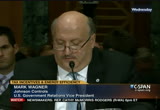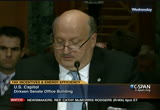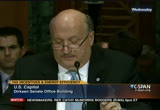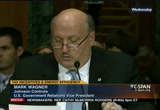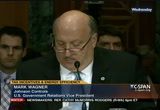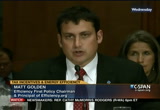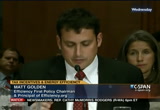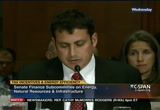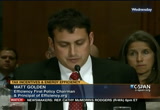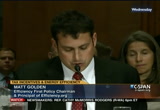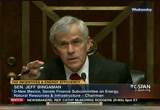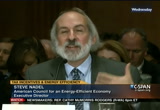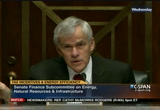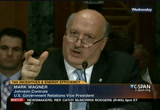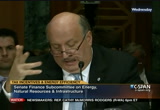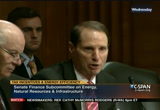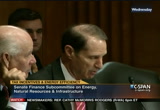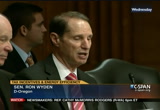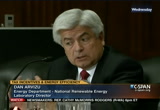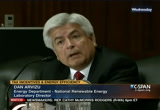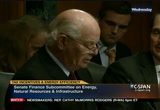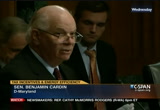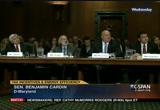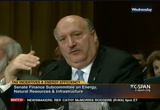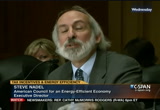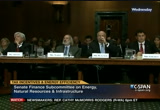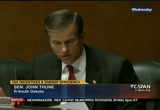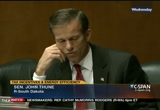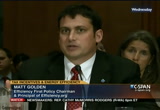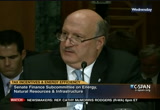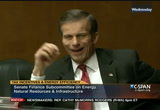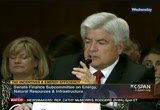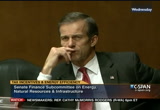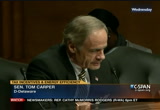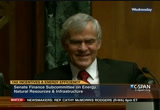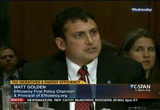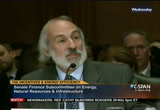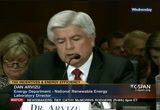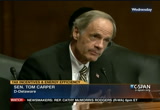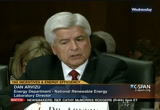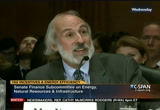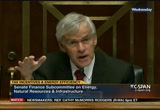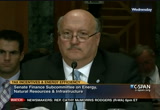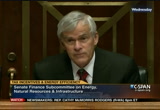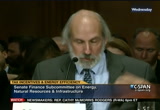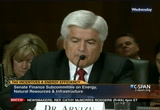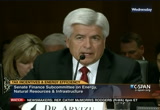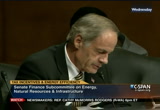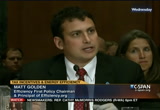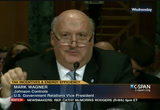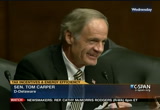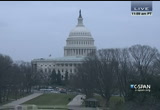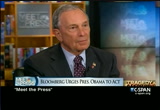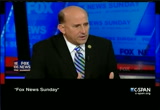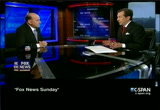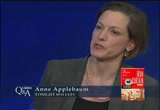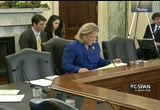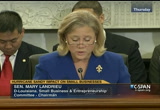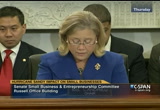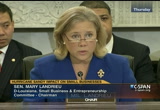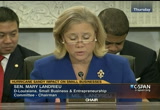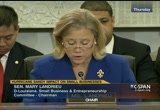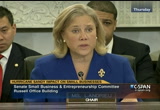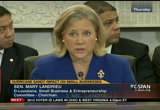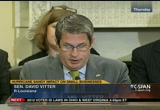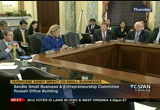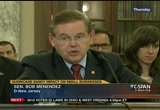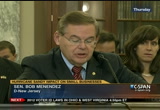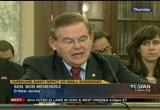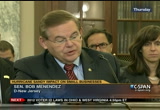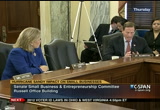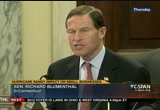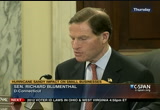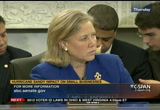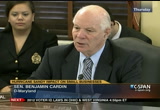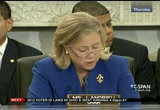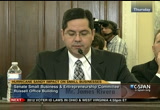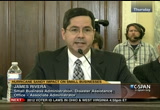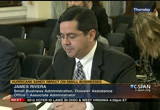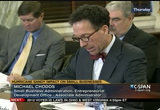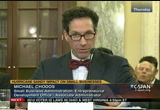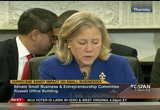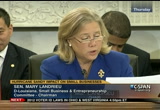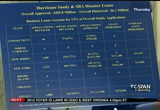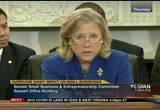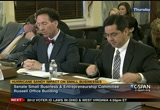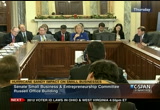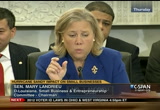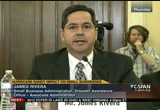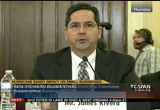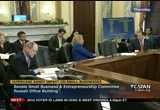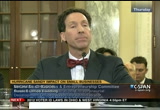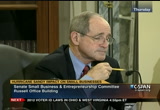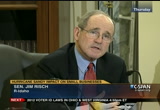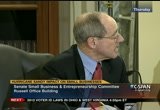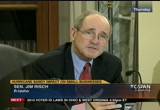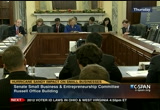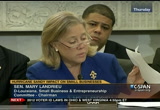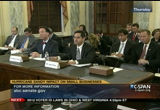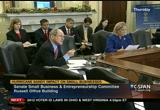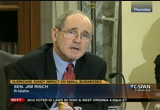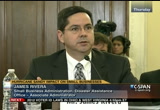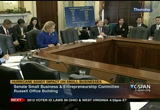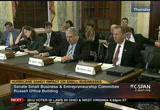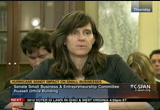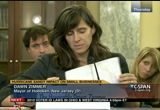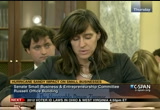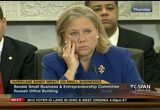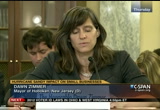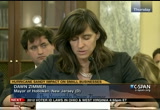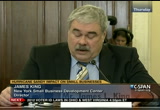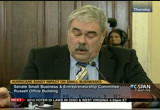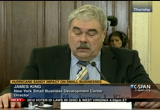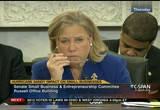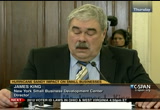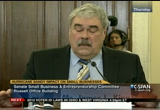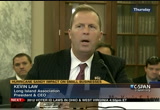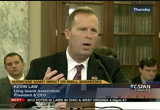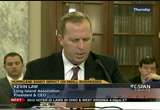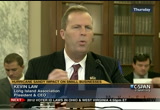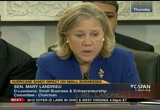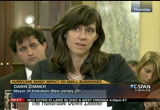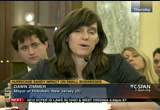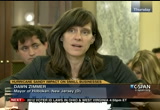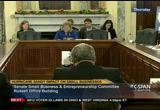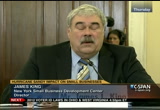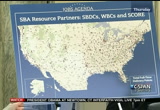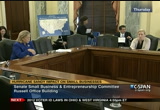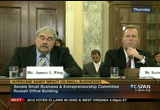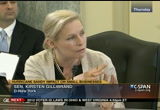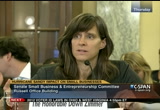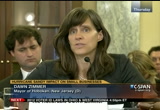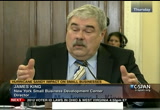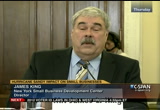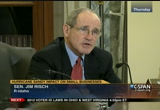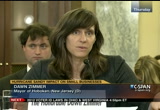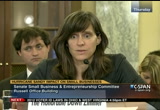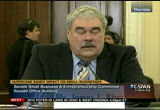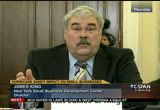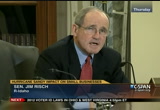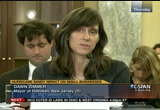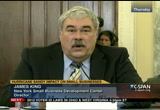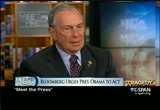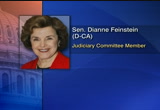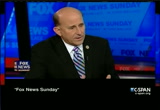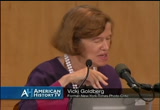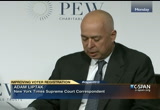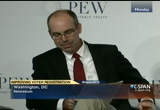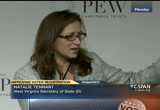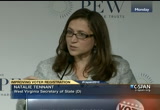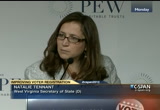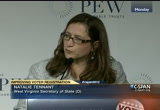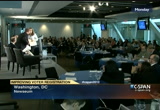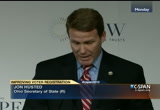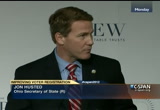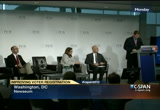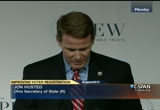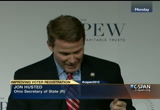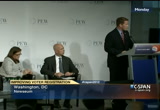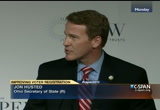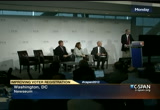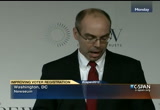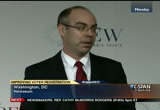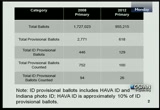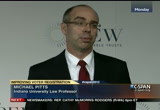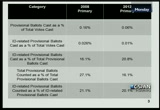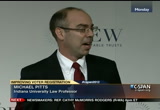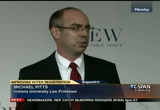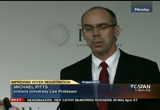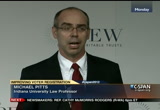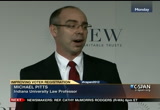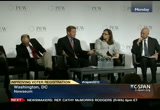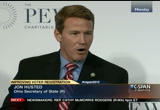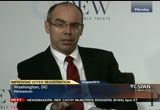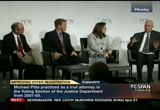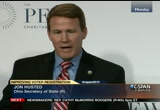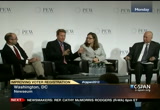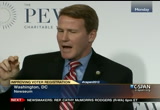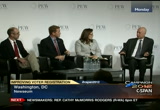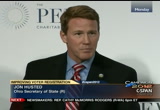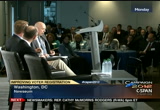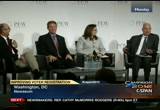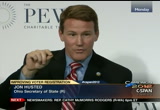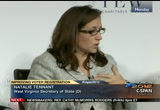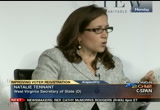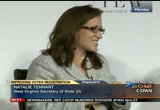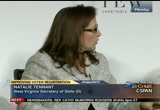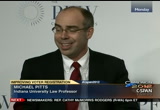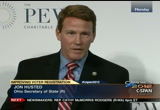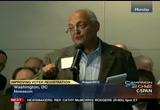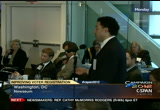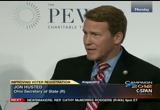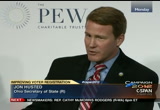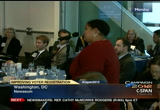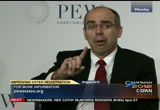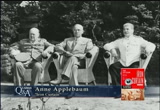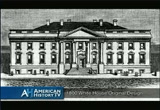tv Washington This Week CSPAN December 16, 2012 2:00pm-6:00pm EST
2:00 pm
this includes public-sector buildings and private sector commercial buildings. the federal tax deduction has been a valuable tool to finance these types of but graves, particularly in the public sector where we have done a large number of projects. let me give you two examples. in maryland, in san antonio tx, we made upgrades at the convention center, airport, and alamo dome. but these are private sector buildings lags behind. despite the large potential opportunities for commercial buildings, shopping malls, and multifamily housing, the tax deduction
2:01 pm
there are a number of reasons why. many private buildings have individually inc. and have no credit ratings, making it difficult to finance these products -- these projects. there is often a fine line between the owner and tenant and you have to make the investment in who gets the benefit. every year, johnson controls conducts a survey of executive decision makers responsible for making investments. in our 2012 survey, we have 3 findings significant to our discussion today. first, we found a 20% increase from the year before the executives to solve energy management as a significant to very significant to their
2:02 pm
operations. they listed access to capital as the largest financing -- the largest barrier to financing energy-efficient projects. third, tax incentives were deemed by far the most important tool with 42% finding it to be the highest for public policy action. the commercial building modernization act addresses many of the unique challenges in an financing energy-efficient projects for the future. first, technology neutral -- giving them the ability to install traditional and state of the art. second is performance based their awards buildings only. third, it provides verification by giving 60% of the deduction
2:03 pm
for the design and 40% after the calculation for savings. the current law requires a retrofit for the code. this would be changed with the sliding scale against the buildings actual energy consumption to the previous years. let me explain why this is important. you are familiar with the upgrade recently completed the empire state building. under current law, that project does not qualify even though we are projecting a 38% energy savings as compared to the building's previous performance. but under this, the empire state building would qualify because savings are compared to the buildings own energy. finally, the legislation provides incentives for the real
2:04 pm
estate trust. start limited liability partnerships. in conclusion, this will expire at the end of 2013. we have joined with 47 organizations from real estate, construction, lending, manufacturing, supply and efficiency communities in support of the extension and a modification you proposed. as we look to the new congress, we hope you will consider the policies and programs that create market demands and provide commercial building owners with enhanced incentives, standardize processes, and financial models that attract five -- attract private sector funding. mr. chairman, thank you for the opportunity to testify and thank you for years of leadership in the senate, particularly with respect to energy efficiency.
2:05 pm
>> thank you very much. >> thank you. i come to this committee as an advocate looking for investors and capital in the energy efficiency market and efficiency first, a trade network that represents over a thousand small businesses and all 50 states. the efficiency first is a strong supporter of this bill which puts emplace the performance- based tax incentives for existing homes. we think the senators for their leadership on this issue. we believe it will drive savings directly to american homeowners. the average american family spends over $1,800 a year which equates to a $200 billion drain on households, representing 22% of energy consumption, one-third
2:06 pm
more used in passenger trucks and cars combined. this will create thousands of u.s. jobs in the hardest-hit industries on jobs that cannot be of course using materials that are 90% made in the usa energy efficiency is unique in that it creates its own cash flow. it pays for itself. there are significant barriers that prevent this from being harvested more efficiency -- more efficiently. one is to begin -- and this is akin to building power plants. we know how to finance power plants. they supply predictable amounts of energy and utility can easily raise capital. however we lack the same
2:07 pm
capital for energy efficiency even notice understood to be the most cost-effective resource for meeting our needs. the energy efficiency efforts equate to a resource greater than any other source in the country. greater than nuclear, natural gas or coal. this is a great example policy that can move the -- this provides incentive to home owners to increase -- the greater the incentive, i the savings. transitioning allows for business model metrology and creates a system to reward innovation. the good news this the systems will need to make this economically sustainable long haul are already here. cost of the contract in injured -- industry is moving towards a month with dedicated companies across the country and leading contractors and manufacturers and trade associations beginning
2:08 pm
to invest heavily in training and resources to move from single measures to pull house solutions. investments have -- this includes work force training, quality assurance and infrastructure that has resulted in projects increasing by 300% over the last three years. utility investments also increase, averaging nearly 20% year-over-year growth since 2005. we are also seeing private investment beginning to ramp up. the first ever securitization for energy efficiency and lending. this promises access to senior capital markets and eventually a much lower cost to capital. homeowners will be able to access loans for energy efficiency at lower rates and better terms. we now know energy efficiency loans are more likely to be paid off. we believe tax incentives play a
2:09 pm
critical role. tax credits directly benefit homeowners without adding wales -- about a it -- without adding layers of bureaucracy. we believe with a combination of smart national tax policy and local infrastructure, we can enable a transformation of energy efficiency that will engage markets and drive private capital. the senate bill, combined with this is an improved step in this direction. reading markets is important, but let's remember small businesses and construction workers that will be helping with these incentives. the energy efficiency industry puts people to work in ways their positive for the community and environment and most importantly helps homeowners meet ends meet. this is a truly unique opportunity to help homeowners while helping the country meet its goals. we appreciate the ongoing efforts of this subcommittee and
2:10 pm
look forward to continuing to support your work in energy efficiency through smart tax credits. thank you. we look forward to questions. >> thank you. thank you to all of you for your statements. let me start with a few questions and then to my colleagues. one obvious issue -- let me ask about this market transformation approach. you are talking about a five- year putting in place incentives that play out at the in the five years. if in fact we have these benefits to be realized in the area of residential and commercial buildings, why does
2:11 pm
not make sense to look at longer-term incentives in the tax code for construction and retrofits of commercial and residential buildings in an energy efficiency way? >> thank you. we advocate initial incentives for five years but then, taking stock of the market and how it's doing and has the markets sufficiently transformed? does the market need to be tuned or modified? as opposed to just something blanket that has never really been reviewed. some of these incentives we think should continue but we should make that judgment call afterward. the appliance credit, they're probably would be some
2:12 pm
refinement needed. in my written testimony, i suggest the option of repayable tax credits to support certain retrofits as the costs start getting too high as ways to support the market without as much cost to the federal government. let's look at it carefully after five years. of the rest ofy you who want to comment -- we have had in the last several years, we have talked about trying to adopt some in the home star proposal as another way to get more investment in energy efficiency. that is a different avenue, but how does it compare with the kinds of tax incentives we are talking a lot here?
2:13 pm
would it make more sense to be trying to get to that kind of a program or should we do both or should we do need their? >> one is a home star approach that was more rebate on specific types of equipment out there and a lot of that was being talked about to try to stimulate that type of approach. the benefit of the tax incentive is one that really helps because of the level you have to reach in terms of the efficiency, it helps drive larger projects that reach a deeper energy efficiency goal, and that is the duty of the tax incentive. you are looking at the yardstick and saying can i meet this goal and you are striving to make more efficient projects to drive more energy savings. that is the benefit of doing.
2:14 pm
>> i think what i understood you say is property owned by real estate investment trusts, which is a lot of property in the country, those properties are not eligible to qualify for the existing commercial building incentive. could you elaborate on that? why is that the case? that is obviously a major problem in the current law. >> it is one addressed by the proposed legislation. currently, in many of these commercial buildings that belong to the large real estate owners, in many of them, they are not accredited, meaning there is no credit history and no assets which can be held as
2:15 pm
security against the mortgage. this kind of makes banks wary of making energy-efficient loans in this area. important int's the proposed legislation to address that. >> my time is up. >> thank you very much. this has been an excellent panel. let me get your sense with respect to where i think we are at this point. we are at the intersection of energy policy and tax policy. the senate finance committee earlier this year made the correct call in terms of trying to start this debate. what we recognize is you ought to extend the current tax provision. at least for a relatively short time. that is what was done with respect to the tax credit in renewable energy so that we
2:16 pm
would not be pulling the rug out from important programs. the question is what happens from this point on? there are a number of us on this committee and that energy committee to lay out some principles early on with respect to what we ought to be working for. i ought to ask your reaction specifically to making a bedrock principle to make a more level playing field between the energy sources. what we have seen, i've sat next to mr. bingaman for more than a decade on both committees. it is important you identify the renewable programs.
2:17 pm
they are essentially on a temporary status and a lot of the other programs and in effect they have acquired a more permanent kind of thing. the kind of programs if we don't have a more level playing field. nor do i think you git out the all of the above approach every senator says they are for. i don't see how you could be for that and not before a level playing field. i'm interested in your reaction, that being a bedrock principle to tax reform as we start to see
2:18 pm
a more extensive discussion. question andreat one that deserves a considerable amount of attention. one thing i would say is we should be making decisions based on the best information that is available and some of those are woefully inadequate. there's a lot of opportunity that allows their to be more thoughtful policy bill on quantifiable trends. it's difficult to know what's going to happen five years from now and even more difficult to know it's going to happen 10 years from now.
2:19 pm
modeling programs are getting more sophisticated. they depended on the assumptions you make in order to understand what the outcomes are but those tools should be transparent. the true cost of all the things that relate to the societal benefits. we are expecting societal transformations to occur over some time and as we make incremental improvements, we have to measure how well we are doing. one of the things i would offer is the portfolio would shift. i think it's great we have natural gas and an expectation the cost will be low for some time. but it is part of a portfolio. we need to be delivered about
2:20 pm
what that looks like and move toward that with a strong understanding of what our policies are in terms of change in the portfolio and what that means. >> i agree we need a level playing field as a bedrock principle. i agree some have temporary breaks and some have permanent ones. i agree everyone should be put on this five-year schedule. every 5 years, we look at it and say what makes us a sense going forward? long term, you get a lot more waste of money that may be is not needed. >> my time is up. if you and mr. goldman would furnish your answer in writing, i would also ask and give us
2:21 pm
your views with respect to how the whole home credit being combined could advance this idea. my colleagues are all waiting to ask questions. >> go right ahead. he's been a co-sponsor of this legislation we have developed and we appreciate his strong support. >> thank you for your leadership, not just on your committee in the energy committee. you have provided the direction for our country that is critically important for our
2:22 pm
national security. it's important for our environment and done right will create jobs in our community. thank you for your leadership. we are going to try to follow in your footsteps. thank you very much. the extension is very important. the provisions that would measure the performance based on the building, the example given by mr. wagner is well taken and the allocation for tax-exempt entities, i think all of that makes sense. other bills, working with the senator -- that gives us a more
2:23 pm
realistic schedule for developers to use school roofs. it gives a reward for historic retrofits for energy efficiency. all of those are performance- based ways we can improve our respect for energy consumption in our environment and economy. i wanted to follow-up on a point about five years or longer. i've talked about the need to evaluate programs. we need to find ways to fine- tune the or eliminate those provisions that don't work and we should always preserve the opportunity to do it. we have gotten into a habit here that has very little to do with evaluating programs and has a lot to do with the use of
2:24 pm
these available tools which we pay a price for that. i want to get the time limit right. but i also want to understand the short-term extensions of credit as to what impact that has on the usefulness of the tax provisions. anyone wish to comment on that? on the short-term dangers? >> i think it is critical because if you do a project on a commercial building, it may take quite some time -- a year or more just to design the effort and enter the construction. if you see where it may have to be in place and working, if you are not sure you can get there, there's the uncertainty and we
2:25 pm
don't know if we can factor that in because we don't know if we can get their for this tax incentive that we are not sure whether it will be reinstated or not. the uncertainty for the business community really put a long- term effect. >> that's certainly true for the tax credits. we see that on solar with the expiration dates several years out. if we were to extend the program for five years, everyone thinks it's five years but it's not. one thing's a few years but the uncertainty creeps in any hurdles needed to meet the standards required by the code may have a chilling effect or
2:26 pm
cost-effective. can we talk about the job? we all know we have high unemployment in the construction industry. does anyone have some help or advice on what we can do in getting people back to work? >> it energy efficiency is very labor intensive intends to create a lot more jobs than mining or drilling. we have always found for each million dollars to invest in energy efficiency, you create about seven net jobs than if you invested in other energy resources. >> we find the whole supply
2:27 pm
chain, the resource center conducted a study that shows 90% of the materials used -- it's not just construction jobs but the manufacturing community. >> along with the building council, there was a report and the proposed provisions would create over 7000 new jobs according to the report. >> thank you. a one to congratulate you on your distinguished service. your leadership will be missed around here. i'm pleased we have the opportunity to do one last energy-related hearing before
2:28 pm
you leave. i agree with the assumption that this is how to examine how this policy is examine the tax code and i hope any deal to address the fiscal cliff will include a pathway for us to get too comprehensive tax reform next year. you have all commented to some degree on whether or not that is the way in which we ought to be doing this, having the irs said mr. these policies as opposed to having them done through other agencies that would be more appropriate. but i want to drill down on the temporary nature of many of the tax incentives we have in the code today. a lot of these things get a underutilized as noted by the sector they are supposed to
2:29 pm
benefit simply because they have this on-again off-again nature. your thoughts with regard to whether we would be better off in setting numerous targeted incentives that expired periodically, moving toward a limited number of longer-term technology neutral incentives. you mentioned in your testimony how that falls into this category of being underutilized because of its temporary nature. your thoughts applied over a long time so you address the economic certainty that gets raised so many times as opposed to these boutique approaches we have in terms of policy today.
2:30 pm
>> the duration for small business and project creation is a critical aspect to the tax policy. in an industry where companies are making investments, these are longer payback times as the business community is evaluating. we also strongly support performance based technology so we don't have to be revisiting the tax code in making adjustments to individual technologies and none of us predict what technologies are going to emerge. it becomes a great equalizer, whether it is for nobles, we talk about valuing the savings as a resource and fundamentally, it's about what emerges at the meter. >> i would have we need to be very careful to make it too
2:31 pm
broad encourage free riders. people are going to do things anyway and if you try to make a very broad, you have to be very careful you are promoting advanced technologies and not business as usual. that can get very challenging. we have to build year based on the baseline for the current home but for places like industry or equipment, those baselines always change and you need to allow for that or else you are going to get free riders with a lot of impact. >> the keys are technology neutral, performance based, and particularly for commercial buildings, having a process where you verify the savings. that's key to showing the savings are real. >> i agree. the only thing i would add is
2:32 pm
there is some merit in this discussion and i encourage we fully understand what objectives we are trying to accomplish and there is an opportunity to aggregate lots of what i would call distributed and smaller type improvements, but when aggregated and allows the private sector to make investments so they can insure reasonable returns on investment, that's a way for success. is about unleashing the market capital in a way that can move that market. >> just as a follow-up to that, if i could ask if you have any ideas about how congress could better design incentives that could be phased out once they
2:33 pm
helped create a market. what we do now was we will do an extension for two years or three years or maybe five years, although the analogy to writing a farm bill might make some sense. i'm not sure you guys want to be in that kind of mess. but is there a way that when you create these things, you face them down at the creation as opposed to going through this annual exercise of having to do extensions and then creating more uncertainty because we have such a short window? does anyone want to take a stab at that? >> i think we can take a lesson from some things other countries have done. i think it comes back to what does it take for the financial
2:34 pm
community to make those decisions in a positive manner? a lot of that has to do on the generation side -- one of the important market mechanisms is a power purchase agreement. it can live for 20 years. that allows enough certainty and even though margins are thin, i can recoup that. what ever is designed needs to be fully cognizant of how the money flows of how the investor makes decisions and to the degree that instrument allows them to make the decision it would not otherwise make, then i think you have a successful one. >> i have two suggestions. when it comes to equipment, you can do it longer-term incentive
2:35 pm
and periodically revised a qualification based on the criteria. the other thing you can do is if you have five years, you can continue to modify and extend further but at least you have an orderly phase-out as opposed to a cliff if congress does not act in a timely fashion. >> which is my normal experience. my time has expired thank you very much. >> i want to come back to the question you asked the panel, how do we structure these tax incentives to make sure we don't just have them expire and extend them endlessly? one of the provisions i worked on is the investment tax credit for offshore wind. it just doesn't help.
2:36 pm
we need an investment tax credit otherwise only have this protection tax credit. we have crafted legislation that says for the first, -- first 3,000 megawatts of the coast, those would be eligible for a 30% tax credit. after that, it's gone. of want to applaud our colleague not just for holding a hearing before being a leader in so many ways on energy efficiency in particular. you know we're going to miss you and i will say that every day until you are gone. i want to say thank you to our panel for being with us.
2:37 pm
sometimes the cleanest, affordable form of energy is the energy we never use. who actually said that first? i think i did. as our nation grapples with air quality concerns and higher energy prices, but energy prices are going down, we need to save energy and figure out how we can incentivize energy efficiency in this country. i often hear from a company back in delaware that manufactures windows that the energy efficiency tax credits has been a significant lifeline and i have heard the credit has been easy for consumers to get their heads around and has been pretty
2:38 pm
successful. as we know, it expired at the beginning of this year and has been extended but has languished since. i realized a number of you would like to make some changes but how important is continuing this tax credit in the near-term. >> i can speak to that. we do recommend some improvements. at the current level, as we understand from our members, they're not driving a lot of new action. while that seems in juxtaposition to the fact need to control costs, we think it ties and the standard that
2:39 pm
making sure we are incentivizing higher efficiency equipment that is more likely to be an upgrade on what is done otherwise. we believe it should be coupled like where we have a more prescriptive path that addresses for the industry is today coupled with what ends up being a much less expensive performance track that brings in more private capital and it is the balance of these standards on the context of tax reform. >> just to add one point, the qualification levels really need to be revised. 85% of the windows being sold qualify and that no longer distinguishes the best from the run-of-the-mill.
2:40 pm
but if you identify the most efficient products, we would support that and in our analysis, it performed quite well if you have that. >> thank you. anything else? >> i want to agree with your statement about efficiency. i have often heard efficiency referred to as -- i like to refer to as the first option. i'm it is easier and more cost- effective to save a unit of energy than to produce it. >> i want to applaud your efforts. that is an early stage technology. >> thank you. my time has expired. would you like me to stop? you may regret that.
2:41 pm
let me stick with this for just a moment. some of our tax hearings earlier, we heard about the need to make the tax code simple and that is one of the things we come back to. we certainly talk a good game. is there a way to consolidate residential and business tax credits into one that would be separate credits? >> i think there is enough difference that they deserve a separate tax credits. from a philosophical and design standpoint, there are a lot of parallels. the commercial sector, i think the common denominator is performance and rather than specifying specific materials, that we continually update. >> i want to make sure i
2:42 pm
pronounce your name correctly. has anyone ever miss pronounce your name? >> several times. kind of name is that? >> it is basque. >> let me focus on industrial energy efficiency. i believe you mentioned in your testimony that industry represents about 30% of energy consumption in this country. there's a huge potential for energy savings in this sector. as we know, manufacturing has picked up considerably over the last few years and many companies are modernizing, which is a good thing. however, i've been told energy
2:43 pm
efficiency projects have a huge up-front cost despite the long- range energy savings which oftentimes prevents industry for making the investments they need. at the same time, our utilities are modernizing to keep up with clean-air regulation. utilities are much more focused on energy production, rather than finding savings. my question is why aren't utilities partnering to implement large-scale efficiency projects for energy savings and does it make sense to incentivize them? >> that is a very astute observation and one of the critical bears. it has to do more with what incentivizes utilities and investor-and utilities to focus more on the generation side. typically one of the
2:44 pm
structures of the features of the business model and to the degree states have taken on some of that and change the model so they are incentivized to save as opposed to generate, i think you will see those wholesale changes. clearly that partnerships as well as the generators is an important aspect to helping to change the business model. these are what i call market structure barriers and do need some serious attention. we have a whole host of regulatory dynamics driving the entire system, so we need to take a step back and understand what we are in scenting and why to get to a transformation. i think there is great opportunity that offer us great economic benefit but only if done properly, only if
2:45 pm
structured in a way that the government's enabling of those market forces lead us to the ultimate objective of getting expendable energy. anything to add to that? >> i agree there are enormous opportunities to save energy and we can and should do more to promote that. in some of the bills, there are targeted incentives. perhaps more could be done. industry is very diverse and what you do in a paper plant is very different from what you do in an aluminum plant. it is hard to have a one-size- fits-all. some utilities are doing a good job promoting industrial energy savings and it involves a process. i would say most are not yet. if they have an industrial program, they do a -- is that
2:46 pm
something the federal government can do to encourage primarily state regulation? to add an extra bonus or something might be possible? we are investigating that but we have not completed the idea of how to encourage increases in capital investment by industry. most of the time, it's in more efficient process these because they have to be competitive. how do your award not just any investment? if you can get more of that investment, you can get more jobs here and get more energy savings. we are looking at that now. we're trying to figure out what the cost would be. money will be tight in washington trying to come up with something, but it looks cost-effective. >> thank you very much. let the record show that you always been so generous with
2:47 pm
giving me all the time of want. nobody else ever does that. >> if you would like to stay for another round of questions, we will be glad. >> thank you. >> let me just ask a couple of questions that occurred to me. it seems to me we have three different issues and maybe more than three. this idea of putting a five-year limit on these credits, i think the mindset that leads to that, at least with regard to some of these incentives, is that we are trying to support new technologies or emerging technologies or early stage technologies, and we want to support them but we won to be able to progress to a point where they can stand on their own after a certain time and
2:48 pm
compete in the marketplace. so that makes sense to have a tax credit or provision to encourage the use of that technology and in phase-in out. it seems to me much of the other things we are talking about really are not of that type. for example, you talked about the idea of being sure you have a tax incentive so a person who owns a commercial building like the empire state building, anytime they can do a retrofit of that building and save 30% of their energy from what they have previously been using, we ought to be encouraging that. it should not be something we do for three years or five years. it could be a permanent part of
2:49 pm
the tax incentives it seems to me. i don't know facing that helped make a lot of sense. if we could properly design a regime for improved efficiency in appliances, equipment, and that sort of thing along the lines where you have an ability to upgrade the standards or qualification criteria periodically, there's no reason to my mind why that needs to expire. one example is this program they have in japan which i became aware of a few years ago where as i understand it and maybe some of you know better than i do how it works, but my understanding is a lot of the different appliances and heating equipment in the market, every
2:50 pm
three years or so, they determine who is providing the most efficient equipment and they set that as the standard and say okay, a few years down the road, that is what we're going to be requiring of everyone so everyone has to step up to that new achievable standard which this top runner has demonstrated is achievable. it's another way of doing what he was talking about, suggesting they be able to update the -- upgrade the qualifications. it seems to me some of these incentives, that doesn't make sense to terminate after a short time. there are others that might be appropriate to phase out. did you have comments on that?
2:51 pm
>> i think you are exactly right. you almost have to ask yourself with the goal is? if the goal is to retrofit a certain number of buildings and that takes x number of years, that is what you do. but there is a tremendous amount of commercial and residential buildings out there that can be renovated under these purposes. i don't want to be frightened but let phase out the tax credit when we're done. >> once we've got them all renovated. >> as a proponent for five years, i would be fine if the money was there, but the residential and commercial buildings keep going. see how much money is available and if we can make them earn it,
2:52 pm
great. we should continue to review them and revise them. rather than the absolute top runner, there needs to be some flexibility in the criteria or like the top 5% -- for some products manufacturer trophy products. if you are to do it for air- conditioning, the trophy products -- virtually none of them are being sold. yet to go lower. >> i think you have hit on something that is very important. that is to categorize the types of incentives you are trying to achieve. if i think back to what was mentioned in the testimony, there's a tremendous amount of opportunity.
2:53 pm
the question is how much of that do we want to capture and who will ultimately vote for getting over the barriers? all of these things have merit, primarily based on the fact that this is a complicated system and the need to think about it from a systems perspective. i think the opportunity for having a transformation begins for a -- depends on how efficient. it makes no sense to shove a bunch of green electrons into an inefficient system. we need to work on the system first and in the portfolio will be optimized in a much better way. not very glamorous, but it should not be underestimated how valuable it is devon energy system that has
2:54 pm
attributes we all x -- we all aspire to. i think the objectives, whether they be grabbing all the inefficiency and squeezing out, that needs to be thought through. i think the private sector has the wherewithal to do that with government support to make the necessary investments. but it is not simple and it may be better done with targeted approaches. >> did you have additional questions? >> i wanted to ask for some parting advice as we prepare to move into tax reform in the next congress. what other advice would you have as we look to the future?
2:55 pm
it's going to be fairly broad. >> in the spirit of the last conversation we just had come we're asking consumers to make investments that have benefits to themselves in terms of lower bills and healthier homes but also have public benefits in terms of clean, green capacity across the grit and other environmental benefits that are not currently -- as far as how they evolved over time, to make up for the gap. focus searcht to to fill that space. as we create data that makes energy efficiency and much more reliable resource that you can
2:56 pm
count on and has displaced new power plants by creating tax credits that evolved over time and potentially in a consistent basis and that is key from a private sector standpoint, as we see these private investments increase over time, that is how we increase -- how we create something economically sustainable. >> thank you. >> one of the things -- we all know efficiency projects have a great return on the investment. i would hope congress would look at ways to stimulate to unleash a lot of private sector couple sitting on the sidelines. how do you do that? how the prime that pump to really get the financing -- what are the keys to doing that, whether it is back stopping dead
2:57 pm
guarantee were doing things that may not cost a lot to the federal government but just say we have unlocked the door and prime the pump and those private sector dollars? >> i would suggest do some analysis to guide these decisions which is what gives the most bank per federal buck and not just rely on politics. there are all sorts of tax incentives out there and then what would you do that would give us the most bang? >> i agree with my colleague. i would be a bit more philosophical perhaps in the thing i would say is i would be heartened if the tone of the dialogue for energy efficiency and the things that relate to and are less political and more
2:58 pm
in terms of how do we move forward? this is not a political issue from a perspective of partisanship. if it's an opportunity to do something that is quite compelling for the country and i speak for a lot of folks in the community and that progress in this arena is long overdue. we would welcome some sophisticated dialogue. >> i don't know if it's just a coincidence, but do you live in golden, colorado? i lived in littleton but the laboratory it is in golden. >> it's great that you guys to come by and share your thoughts with us. thank you. >> thank you for your
2:59 pm
involvement in this issue. thank you very much. think it has been useful testimony and we will adjourn the hearing. [captioning performed by national captioning institute] [captions copyright national cable satellite corp. 2012] >> in the wake of friday's shooting that took the lives of 20 children and six staff members, the sunday morning talk shows focused on the possibility of stronger gun control legislation. michael bloomberg was a guest on meet the press. here is a portion of his comments.
3:00 pm
>> i think the president should consult the country. he is a the commander in chief also. he called for action to years ago. every time there is a disaster like this everybody says now is not the time or if you have fixed the problem we cannot guarantee that this particular event would have been prevented. all of that is true. it is time for the president to stand up and lead until this country what we should do, and not go to congress and say what you want to do? this should be his number one agenda. he's the president of the united states. thousands of american will be killed with illegal guns. that is roughly the number in the whole vietnam war. >> dianne feinstein also was a guest on "meet the press."
3:01 pm
said "i will introduce a ban of assault weapons. it will ban the sale and possession prospectively and it will ban the same for drums or strips of more than 10 bullets." louis gome it was a guest on fox news sunday. here is his reaction. >> every mass killing of more than three people in recent hearing -- history has been in a place where guns were prohibited. they choose this place. the they know no one will be harmed. having photographs of these horrific scenes and these
3:02 pm
children have these defensive wounds as they try to protect themselves. they are lunching, it trying to protect. when she heard gunfire she pulled it out and she did not have to lunch with nothing -- lunge with nothing in her hands. >> i understand the right to bear arms. the supreme court has made it clear that they made it clear when it put it in the constitution. why do people need these semi- automatic weapons? is reading about the glock. 5 bullets a seconds. this was treated for the military. i can understand a hunting rifle. why do they need these weapons of mass destruction?
3:03 pm
>> a free people should be an armed people. it insures against the tyranny of the government if they know the biggest army is the american people. that is why it was put in there. when she saw -- once you start drawing the line where you stop/ >> president obama will meet with families of the victim's. he is expected to be the final speaker at a bit so this evening. we will have live coverage beginning at 7:00 a.m. on c- span. >> i wanted to explain how it happened. we do know the story of the cold war. we have seen the archives.
3:04 pm
we98 know the main events from our point of view. we read them. what i want to show what it felt like to be one of the people who were subjected to this system. how the people make choices in this? one of the things that has happened since 1989 is the region of eastern europe has become very differentiated. the don't even have much in common with one another. >> more with an applebaum on life in poland and hungary. tonight at 8:00. >> on thursday, local officials from york and new jersey urged congress to approve a
3:05 pm
supplemental funding for its cities affected by hurricane cindy. two officials with the small business administration testified. this is one hour and 45 minutes. >> good morning. thank you for joining us today to discuss the small business administration's response to hurricane sandy. i've of like to thank our witnesses that will be testifying in just a moment. i will introduce them in just a moment. let me make a couple of opening statements. we are here today to evaluate the response and recovery effort in the aftermath of hurricane
3:06 pm
same day as the largest ice storm in u.s. history. hurricane zandi claimed the lives of 130 to americans, it damaging and destroying more than 600,000 homes and 459,000 businesses leaving more than 8.5 million families with out fire or running water. most of the power grid has been turned back on. they're still communities that are challenged. the scale has treated significant challenges. this a require a sustained effort a part of the local officials. voluntary earlier this week i had the chance to tour some of the tristate area.
3:07 pm
they took the opportunity to tour the area. we have both republicans and democrats with their eyes on the disaster. one of the reasons we are here today is to make sure the federal government is doing everything in its power to assist the thousands of small businesses that have been hurt in this natural disaster. by in large, the federal response has been robust to hurricane sandy. more than 5 hundred,000 people have registered for temporary housing. fema is on the ground has provided over 15 million meals, 20 million liters of water, 7 million blankets and 700,000 tarps.
3:08 pm
d.o.d. delivered gasoline to over 300 stations. and millions of gallons of sexual warp were pumped out of the tunnels. i want to take a minute to thank, again the first responders at every level from fire houses to police stations to volunteers in the neighborhood as well as the national guard from so many states that came to the aid of the northeast. the president and numerous administers have been on the ground meeting with the leaders. the governors of new york and new jersey have been here to express their desperate need for help and support.
3:09 pm
i want to start with positive statistics and go into a few areas that i'm concerned about. one of the areas i'm concerned about is the fact that they have only approved two and half million disaster loans. however, the disbursement while those numbers sound impressive, the disbursement is only six million and we want to get to if bottom of that today. i understand this number is expected to grow and as this statement was put together those numbers have changed. i think it is important to keep our eyes on the results, what is happening on the ground for businesses and homeowners making decisions about when to rebuild, how to rebuild, and where to rebuild. if they are going to rebuild, it is a big decision. as chairman of this committee
3:10 pm
and senator from one of the hardest hit states in recent years i believe one of the most -- biggest responsibilities is -- i took the opportunity as chair of this committee to ton up this response. i'm proud to see it in operation today. in the past, planning was insufficient, staff and funding came up short. there were immeasurable delays, red tape and paperwork. following the 2005 storms that took over 74 days to process a home lone and 66 days to process a business loan. even longer for disbursement of disaster funding. they pushed disaster victims that were lost in the flooding. i hope we will hear testimony that the red tape has been eliminated, that we're not requiring survivors to produce
3:11 pm
multiple copies of tax records that in many cases were lost in the storm itself. so for this reason i'm pleased to see we've had a great deal of improvement with the f.d.a. but i want to note that these reforms included a disaster loan limit increase from business from $1.5 million to $2 million. new tools were authorized following catastrophic disaster. improved coordination between i.r.s. and fema. and very importantly, allowing nonprofits for the first time to be eligible for economic injury disaster loans. if this in a storm like this the first groups that are going to be turned to is your volunteers, chamber of commerce, your local organizations that
3:12 pm
were themselves devastated, losing headquarters, losing member, losing staff members, sometimes in loss of life. people have moved away or not living in the community where they lived. it is important get these nonprofit organizations back up. they will become the leaders in the recovery. building on these reforms the 2010 small business reform jobs act allowing a culture businesses to receive economic recovery loans. i hope these will come in handy this time around. so i'm pleased to report the time prime for home loans has been reduced to 74 days. business loans from sandy are averaging 10 days compared to the 66 days in 2005. however, i do think we need to do more in terms of getting money on the ground and we'll
3:13 pm
share of what you have shared with us in terms of actual disbursement. we also need to modify requirements that borrows must use their personal homes as collateral when other collateral is available. i have asked that to be in the supplement to give borrows the max flexibility in a time like this. especially in businesses that have been utterly destroyed and i saw for myself, thousands just the few hours i was on the ground but we were in new jersey, no long view beach, a small community. i think the mayor has been there and his father was the mayor before and he said he has never seen anything like this in 50 years. and block after block after block restaurants, gas stations, toy store, barbershop,
3:14 pm
hair dresser, on and on, just completely gutted with the debris out front. we've seen these visuals before at home and it is heartbreaking. right now, in a very sensitive time of the calendar with holiday season, with christmas coming up, some of these businesses have invested their entire lives and sometimes seasonal because you are on a coastal area. have to make a decision if they are going to reopen for memory day. getting these loans out for the taxpayer is what our goal is. i'm not going to go into the examples that i have about some of those businesses because i do want to hear from the leaders of the small business administration. i will say that the president
3:15 pm
sent up just yesterday, a day before, a $6.4 supplemental request and a chairman issued his mark last night and that document is now public. i believe that the sooner we pass the $6.4 supplemental which provides essential mitigation, help for small businesses, homeowners and most importantly, flexible community development disaster grants is absolutely essential for the recovery of this reason. because as we knew going after ike, katrina, and rita, if the people don't have confidence that their local leaders have been given access to serious money and $60 billion is a serious amount of money, they will lose hope because the disaster is so overwhelming and that is the last thing we want people to do is lose hope.
3:16 pm
you need to harness the human spirit to believe they can rebuild these communities in the face of overwhelming odds and build them stronger. so we're going to get into the testimony in a moment. i want to call on senator vitter and i want to thank him for sitting in for senator snow. then we're joined by senator blumenthal and i'm looking forward to his comments and their constituent in this situation. senator vitter? >> thanks, madame chair. i want to make three points briefly. first of all, again, i want to express my real sympathy for all the victims of sandy. this was a horrible,
3:17 pm
devastating disaster, wiping out homes, businesses, and livelihoods and it has a tragic human face and we need to keep that in mind. i'm certainly supportive of acting quickly in terms of help and aid that is going to directly, immediately help those victims. we also need to do that in a thoughtful and responsive -- responsible way with the american taxpayer in mind we can do both of those things. so i certainly support that. secondly on the s.p.a. side i think there is good news and there is room for counting improvement. the good news i do think we've come a long way, positively since katrina and rita. and the s.p.a. disaster response has been improved. the response in 2005 was slow an inadequate before steven preston took over and turned the program around and it has
3:18 pm
improved since then. we were able to work on this committee in a bipartisan to write and enact further reforms that the senator mentioned. i was proud to work with others on the improvements, including the disaster reforms and the 2008 farm bill. but we can continue to learn and can continue to improve and enact reforms and we need to do that, including in this context. third and finally, i want to touch on an area that is outside this committee's jurisdiction but very important which is the core of engineers and core reform. the corps is also another federal agency that is very important in regards to any disaster like this and we have to improve the process and address real reforms so we can work quickly and adequately
3:19 pm
address needs like this. we've been working on that including in a bipartisan way and i hope to include many further significant corps reforms in the next bill that senator boxer and i are working on now. again, thanks to all of you and i'm certainly all ears. >> thank you. i would if i could, senator menendez has a time crunch would you allow him? thank you. senator you have been such a champion for the people of new jersey so thank you for joining
3:20 pm
us this morning. we're happy to hear your opening remark. >> thank you for the opportunity and thank you for coming to new jersey with several of our colleagues and touring the devastation along the jersey shore. i want to thank senator vitter who is on his way to join us and you feel, the weather has deviated his flight. >> he has a wonderful tour of the airport. >> it looks better than what you would have seen in new jersey. so thank you for your effort. madame chair you and senator vitter are no strangers to natural disasters and you have been an important friend and all lie in understanding the lessons of katrina. this is the worst natural disaster that my state has ever faced.
3:21 pm
it took houses from their foundations, it changed the typography of the coastline, it devastated some of the most densely populated communities in the country, and it took lives and property. more than 2/thirds of our businesses lost power. many still today have their -- not only their lives disrupted but costing a lot more to make their transit to work. so much of their income is being bit out of the process. countless number of businesses are facing an overwhelming job of cleaning up and getting back to business. in new jersey there is 34,000 applications for small business loans that have been submitted. it can often take weeks if not months to get back up and running. revenue lost at the worst
3:22 pm
possible moment and as you saw on monday on long beach island, power is still not restored and small businesses are still closed as a result. while loans can be helpful many small businesses don't have the capacity to add more depth to their books. small business owners around the state have told me they have already taken out significant debt to survive their business, survive the recession, or to repair after hurricane irene struck. i see the mayor is here and he's going to tell us some of those experiences. they have full time and part time employees and they lost weeks, they could not make the represent.
3:23 pm
despite their own struggles when the shelter did not have electricity they gave up their stock so they could light up the place with candles. that is the type of response we've seen and there is so much more so. madame chair, what you are doing here is very important. final comment is, i appreciate what we're considering that has moneys that can give us the ware with the flexibility based on some of your own experiences in louisiana to be able to give them a grant which may very well make a difference between staying open or closing or getting open and closing or getting their business back or not. in doing so also hiring so many people that were hired by these small businesses which are the engine of our entire economic background.
3:24 pm
i would ask my con except of my entire statement put into the record. >> without objection. >> thank you. i want to thank you for giving me the opportunity to participate this morning and for your involvement for your outreach in new york and new jersey and in connecticut and not just this disaster but going back to 2011 and the catastrophe that connecticut suffered when you personally contacted me and offered assistance. i want the people to know that they have a real friend in the senator of louisiana. your leadership has been tremendous in this area. i want to briefly say thank you to the president for providing the strong leadership that he has in the wake of this disaster in connecticut.
3:25 pm
he promptly declared connecticut an emergency area and that permitted the s.p.a. to come along with fema and the people on the ground that have been there for quite some time, many of the fema officials in advance of the storm. unfortunately, many of these recent storms and their scope and depth and the devastation they cause that we may face a new normal in this kind of catastrophic weather-related event. we need to prepare in the longer term as well as the short term that why the suggests made early this morning and other improvements will be made are so critically important.
3:26 pm
i think you need to know that the connecticut s.p.a. office has approved $6.7 million in disaster assistance for struggling business in connecticut as well as residents. that figure is significant but there are a large number of requests for funding that is still being processed. therefore, a large number of homeowners and small businesses that need assistance their request for assistance, quite frankly, are still in the pipeline and we would appreciate even quicker attention and processing of them. nearly a month after hurricane sandy many connecticut residents are still waiting to hear if they are able to repair their storm-damaged homes.
3:27 pm
and small businesses are waiting to find out if they will have enough capital to retour their businesses to the pre- disaster conditions. they put their lives and their livelihoods back on track, they deserve to have that opportunity and i hope that the supplement will be approved quickly with the additional $250 million that will be able to service these loans as quickly as possible. i appreciate your assistance. i hope we can contact you, reach out to you, and work with you to accomplish these goals. thank you. >> senator cardin. >> i want to join you in thanking you. we had many conversations in the legislation that i hope you will be considering as early as today the supplemental emergency is critically important. for the small businesses and fema, and the department of housing all of those are critically important for the recovery of the communities
3:28 pm
that have been so devastated by sandy. maryland was hit hard, not as hard as new jersey and new york and our prayers and help go out to those communities that are broader in the amount of damage that was done. but if you live in chris field, maryland, the community of 1/3 of the population lives below the poverty level. you are looking for the government to help you during this time and that community needs the assistance. if you live in the other part of state where almost every home lost power, 3,000 trees came down. 30 inches of heavy snow fell in a short period of time. both ends of our state were hit very hard and need help from
3:29 pm
the federal government. i very much appreciate the fact that this committee is holding this hearing to see how the small business programs can be effectively brought into play during this disaster to help small businesses. oakland, maryland and crisfield, maryland have something in common, their economies are depend event on small businesses. that is where the people work. we do need to focus on how we can help the small businesses get back on their feet so we can have the type of economic progress in both of these communities that have been so disrupted because of sandy. let me also thank you for your help on an issue that was brought up during this committee. it worked successfully, it
3:30 pm
helped create jobs and i appreciate the fact that you are addressing that also in the supplement. and thank you for your help. i think that will also provide some additional relief to not just the communities affected by sandy and our country in helping small businesses deal with our current economic pressures. thank you for this hearing. >> thank you, senator cardin. michael chodos is with us, he is responsible to oversee the training programs for current and future entrepreneurs. i'm going to ask him to speak second. i'm going to ask james rivera to speak. but we asked michael chodos to be here because he is responsible for the counseling, mentoring, and training which is going to have to step up their game in the northeast. they are going to need the
3:31 pm
training to get back on their feet, potentially change their business model, potentially make some adjustments to keep them in business. we're going to start a second panel in about 20 minutes so please keep your comments to five minutes. >> thank you for inviting me to discuss the efforts in response to superstorm sandy and our role in the recovery. we appreciate your support to make our country better equipped to deal with natural disaster. we've seen first-hand the damage cause bird sandy. as you know, the damage is
3:32 pm
immense. this is one of the largest disasters that we've seen since katrina. i can assure you that the federal government is leveraging all of its resources to provide timely and all of its assistance. we're working closely with fema. we're closely coordinating with local and state agencies with local officials to make sure we're doing everything to assist the maximum number of businesses and homes. we're providing an one s.b.a. approach. thus far, we have deployed over 300 representatives to the region. as you know, we are providing -- is responsible for providing affordable, timely, and financial answer in the form of low interest loans in
3:33 pm
homeowners, renters, and nonprofit organizations in the aftermath of a natural disaster. we have made a number of improvements over the years. we have reduced disaster loan times, streamlined application forms and have electronic application process. we have now designated a case manager for each approved application so borrows know their principle point of contact when they have a question or need help. last year we signed a memorandum with hud. to ensure those with unmet needs.
3:34 pm
superstorm sandy, disaster survivors in new york, connecticut, rhode island, all received presidential disaster declarations can apply online or any of the centers, including the fema recovery centers. additional north carolina and virginia received an administrative disaster declaration. today, we have approved over 3600 applications for over 200 million. many survivors don't have access to radio, television, or internet. to address these situations we have a service center that is helping with the calls. as of this week we have met more than 50,000 people on the ground. s.b.a. has responded over to
3:35 pm
80,000 phone calls at its disaster service center with a wait time of less than 60 seconds. we have over 2,300 employees working on superstorm sandy. this is in addition to all of our resource partners. if they are on the ground or at the resource center we're focused on one goal, meeting the needs of the families and businesses who are affected by this tragic event and helping to rebuild after this devastating storm. we're committed to do the hard work to ensure these small business owners are able to emerge stronger before the
3:36 pm
disaster. i appreciate the opportunity to update this committee on the recovery efforts. we believe that the reforms we've instituted are helping us to respond to the needs of the survivors. i look forward to answering any questions and thank you. >> thank you. mr. chodos. >> thank you for the opportunity to testify. since sandy struck, s.b.a. has been on the ground across the region providing individuals and businesses with information, support, and access to disaster recovery loans. as communities rebuild, s.b.a. is there from day one and we'll stay deeply involved over the long term. that is why, in addition to our disaster response team, our office of entrepreneurial development and our partners play a key role in immediate disaster response and in helping the small businesses restart, rebuild, and thrive again.
3:37 pm
there are hundreds of thousands- o small businesses affected in the area. with 44 small business development centers, 14 women centers, our partners work together with s.b.a.'s center tow help staff of disaster recovery centers. and they set up informational events in communities across the area. in this early period we help our business owners map out the process, collect information, and apply for disaster loans. they also connect business owners with local, state, and federal resources. and they help small businesses
3:38 pm
take the first concrete steps to get the capital, resources and mentoring they need to get back up and running. for example, our new york s.b.a. created a one-stop website to provide information about important resources for small businesses. it is now a critical tool for individuals and businesses across the state. in addition to access to resources, thousands of affected businesses will need individual help one business at a time. in just one recent example, our women's business center in the bronx was contacted by a local manufacturer and distributor which experienced significant damage and needed help accessing capital. we helped them apply for a loan, reviewed its information and plan, and helped it craft a long-term plan to recover and rebuild. this process is being repeated by volunteers across the region and will increase substantially in the upcoming months.
3:39 pm
those who receive counseling and training are more likely to start and their businesses are more likely to survive and they are better prepared to have economic growth. we will play a key role in economic growth across the region. in addition to the on the ground support, s.b.a. takes a comprehensive tri focused air approach to strengthening and rebuilding sectors where small businesses are hit the hardest. no small business is an island. every small business has its own suppliers and vendors and thousands of small businesses across the region in turn, play a key role in masters, and distributors. through its extensive experience with regional innovation clusters, we know that successful, economic growth
3:40 pm
comes with connecting small businesses with growth capital and supply chain connections. our initiatives work. we plan to use what we've learned to support targeted, network economic development in affected industries across the region. inspects are already on the ground and we'll make sure that the businesses get the help they need in the months ahead. we thank you for your support and we look forward to answering any questions. >> let me just sub mitt for the record one of the successes as post sandy, post katrina was a more efficient application process. i want to submit for the record the two-page disaster loan, the one page personal financial statement, and the one-page
3:41 pm
request for tax information. the fact that that has been streamlined is very, very important. as i said, we still have a great deal more to do. and without objection i will put that into the record. let me make sure i start with the facts because it is a long haul. senator vitter and i are in the seventh year of recovering from katrina. i don't want to frighten people listening to this but it is a long road from recovering from a disaster. i just want to start with making sure we know what our challenges are. the record that i have and i want to see if it matches with what you have. in new york the documents that have been submitted show that there are 265,000 businesses that have been destroyed.
3:42 pm
in new jersey, it is 189,000. is that generally the records that you have, mr. rivera? >> yes, that is correct. >> just for comparison in katrina which is a no question catastrophic disaster on the gulf coast, we only lost 18,000 businesses. 265,000 businesses have been lost in new york and 19,000 in new jersey. now the only program that i know of in the federal government that is specific to meet the needs comes through your agency.
3:43 pm
we're pushing very hard for the community development grant to change into a much more flexible and better designed tool which is one of the primary tasks in this supplement which i hope congress will say yes. maybe use some of that money to craft more robust assistance. but given that, you can understand why i was a little bit concerned to hear that in new jersey we have 11,498 applications. 68 have been approved and nine are disbursed to date. in new york city, we have 105 have been approved and 12 loans have been disbursed. at the average loan, according to the documents preparing for this hearing was $13,000.
3:44 pm
i understand those loan amounts have been increased because this is a real moving target. every 24 hours these numbers move. but just to give some reference in sandy -- i mean katrina the average business loan was $1,116, wilma was $135,000. wet we're at a fairly low amount for sandy. that number will go up, the afternoon loan amount. but i want the members of this committee to know and for the administrators to know that my eyes are on the results, not the process, no how many people we have in the field, not how much offices we have open, not how much money we're spending. my eyes are going to be for the next year with the help of this committee, and i think i have
3:45 pm
the support of both republicans and democrats on this, on the results of getting loans quickly into the hands of businesses or grants. it is impossible for these communities to recover without small business leading the way. it is just not going to happen. homeowners can rebuild but if there is no gas stations open, if there is no retail shopping centers, and i'm telling you seven years after katrina we still have neighbor neighborhoods that are looking for business opportunities. i don't think the federal government can do it all but i think the federal government can be a big supporter in this effort and i'm looking for smart partnership. can you please comment on these numbers and keep your comments short because i have another question. >> you are absolutely correct. we are very early into this disaster.
3:46 pm
generally we get most of our applications between week four and week eight then we have a 14 to 18 processing goal. this is week six in the disaster we're starting to get an influx of applications and we process within that time frame. but we're confident that we're going be able to get these applications processed timely. once we get the loan approved, we will generate the loan approving documents and get the disbursement out within the first five days of the application itself. >> let me ask you this. what are the deadlines for the application? i believe we may have to have those extended. in my experience people are so traumatized after the disaster. they are having a hard time getting their head around the fact they lost their home, lost their church, lost their business. it is difficult to make
3:47 pm
decisions, particularly, when you don't know what your neighbors are doing or the business next door are doing and people may need more time. what are the deadlines and do you have the authority to extends them? >> the current deadline in new york was just recently extended for all the states the deadline is december 31 and in new york city the deadline is january 28. we'll work with fema to see if we can get a possible deadline. >> so you are saying you do have the authority to extend deadlines if you find it is necessary? >> we don't but fema does because it is a presidential declared disaster but we're going to work with them. >> i'm going to ask the next panel if they believe their businesses in their communities need more time. my third question, explain in some detail if you can, what the preliminary conversations have been with secretary of hud who is probably the best person in america to lead this disaster. he is educated, well- experienced, and from that region.
3:48 pm
what have the ex -- what have the initial conversations been about some expressed business loans, $20,000, $25,000 loans to proven successful businesses. i'm not talking about new entrepreneurs taking opportunities in the aftermath as legitimate as that may be. i'm talking long-standing businesses. so we can answer the question are loans the only thing available. what is your answer to that and what are the outlines to our preliminary discussion? ande're working with hud he's going to be the point person with the president in responding to superstorm sandy across the area. we've had discussions on the flexibility on how we can coordinate. we had the memorandum that we
3:49 pm
had signed thanks to your efforts. we're looking at how we can coordinate the loans and how they can be provided as part of the supplemental. >> have you gotten into a discussion on small grants or is that preliminary? >> we're still early in the disaster, we're working as hard as we can, to get the best results we can.
3:50 pm
>> senator blumenthal? >> one quick question, can you comment specifically on the different alternatives in terms of collateral that maybe available, senator andrew raised that point earlier. >> we follow the private sector practice. we will generally take the business assets and if there is a residence available we'll pick up the residence but as part of the proposed language we'll see from our perspective how that works but we do follow private sector practices. >> well, would you use collateral other than someone's home? would that be a departure from existing policy? >> yes, it would be a departure from our existing policy. we would look at what other collateral is available. >> so you will undertake that policy? >> we will come back once the legislation is passed and see if that is the best approach we can take.
3:51 pm
>> thank you. >> senator risch. >> you used an example since the catastrophe, where did you say it was, new york? what kind of business was that? and what type of insurance did they have? >> i will have to get back to you on that. i will say the availability of insurance is one of the key items of information that is obtained when a business is applying for immediate, either fema grants or s.b.a. disaster loans. so getting the full packet of that information is part of the intake process. more broadly, our resource partners who help staff the recovery centers take a holistic approach when a business walks
3:52 pm
in the door to find out where they are overall. what do they have? what are their needs? what is the plan going forward? >> perfect except i'm looking at the business loan application and it has a form number and what have you on it. if i was a claims processor or someone in your position looking at one of these, this thing would be incredibly short of information when it comes to making a decision as to whether taxpayer's money should go into this. i look at item 16, insurance coverage and in par rent that cease if any. you don't ask how much coverage a person has. you have coverage type, name of agent and policy number. i haven't had time to study this thing and maybe it shows up somewhere else. >> that is part of the application process. basically, the loan officer has the discussion with the disaster survivor and the insurance agent.
3:53 pm
3:54 pm
interruption, they can check it very quickly. it seems to me it to be critical when you're examining one of these claims. i assume that you have a group that works with the claimant as far as dealing with their insurance company. dodge the loan officers deal with the actual agent when they process the application. >> and you feel comfortable with their expertise? insurance companies can be somewhat difficult at times when it comes to claims. >> we have pretty good success dealing with the disaster survivor and the agency. >> i can see i am way over, but i have a number of other questions. in any event, if i were you, i
3:55 pm
would take a look at the application form. i don't want to see a form that looks like a phone book, but i have this idea of keeping it simple. but it seems to me you need more information than what you have. go back to katrina. the chairman indicated there were 18,000 businesses, what percent had insurance? >> i will have to go check the records. i was not with the office of disaster assistance at the time. >> it would seem to me that it is a critical question. can you give me a ballpark? >> i don't venture to guess, but we can get that information for you. >> i am disappointed in that. did you do anything with katrina as far as making it a learning experience?
3:56 pm
>> absolutely. we have a pretty good prepared this package that goes out and we talk about insurance being key. we do make loans of fraud and we will take it out of the insurance policy. there are lessons learned, but i don't want to state a specific percentage without knowing the facts. >> also on the 189,000 in new jersey, i would be interested in how many of those people have insurance. i am assuming that you would agree with me that it is critical, people looking to the federal government has that been? >> that is part of our process. we will make a loan for $100,000. we will either make a loan upfront or reduce the full amount by the 50,000.
3:57 pm
or will make that loan. >> and will you also take an assignment on proceeds? >> we do when the insurance is settled. >> i think that is enough for this round. >> we can get that information, i think it is very important. it has to be completed and attached to this? in addition to the pages that the senator pointed out we want a simple process. there is one from the insurance, one from the irs, another 22 02 that is scheduled to fix liabilities. please let us know. the insurance is required and a very important. it is helping to fill the gap, sometimes those insurance proceeds can be very slow. frankly, some are much better than others honoring the
3:58 pm
contracts. that is another important oversight that i hope the committee jurisdiction can provide in this recovery. are there any other questions? i would like to move to the second panel. >> we have been hit with a $60 billion request. >> it came from the white house and the appropriations committee. >> what part of that would be attributable to this jurisdiction?
3:59 pm
4:00 pm
>> i have one other that is not related to that. who put those numbers together? >> which numbers? >> the numbers that you just gave us. >> part of it is the office of disaster relief, then there is the bond peace with capital access. >> i assume that we can get in touch with you? when someone applies for a small applies for a small business administration loan, is there insurance bet it? >> yes, sir, only when the loan officer with the application. the have to contact as part of the processing effort. >> anyone with a small business loan will receive compensation from their insurance company as opposed to having an issue? >> that is one of the decisions a small business owner needs to make, if they have small
4:01 pm
business insurance. or they feel they are under- insured. >> when you do due diligence, do you require that they satisfy you that they are fully insured to their interruption in business and that sort of thing? >> we have exactly what the insurance settlement is at that time or what they anticipate it to be. >> sorry, talking about before any disaster. >> for a disaster loan? >> i am looking for so and who comes in for a loan. >> there is a guaranteed loan program to the banks. that is part of the normal private practice that insurance requires. correct.
4:02 pm
>> if you can give me these kinds of numbers, what you find as far as people with a loan coming back and wanting a loan or disaster for something like that? >> for an individual that has already received a loan? there is an opportunity in the event that there is under insured losses coming where we might require flood insurance and there may be additional damage around the flood insurance policy and what it covers because of the different footprint for the different type of event that occurs. >> thank you. >> senator, we can -- >> we can get you information about the program. the default rate is very comparable to the private sector in default rate. it is a modest subsidy for that program.
4:03 pm
relative to the leverage it provides the small businesses, a lender of last resort. i want to make clear and i think the senator has a very good line of questioning that insurance underlies this whole recovery process. these insurance policies can be expensive, but is required. the small business loans are there to fill the gap or to get money more quickly until insurance proceeds come in, but it would be important to submit how many of the businesses that are successful in not just apply in, but receiving loans, what is their level of insurance coverage? let's go to the second panel if we could, thank you very much. thank you will, and if you could stay and listen to the second panel, i would appreciate it. i think it is very important to hear from the mayor's and business leaders on the ground. the first female mayor of the
4:04 pm
new jersey in 2009. the mayor began a career advocate for public parking space and has been a successful mayor dedicated to fiscal responsibility, public-private partnerships and improving the quality of life for local residents. hoboken is one of the more devastated municipalities and regions. i know they can appreciate what you and your city council and citizens have been going through. let me offer you our best in this effort. mr. king has been the state director of the new york small business development center. he oversees 24 regional centers, 35 outbreaks centers.
4:05 pm
all of your experience must certainly be called bond at tested for the job that is ahead of you. the president and ceo of long island association, one of the most respected organizations in new york. he long island economy is made up of businesses, 90% employ 20 people or less. we are interested in what your businesses are saying, how we can be as helpful as possible. our hearts go out to the people that you have lost and the devastation. make sure that your buttons are pressed and you're speaking directly into the microphone. >> good morning, committee members. it is a privilege and honor to be here today. hoboken is located just across
4:06 pm
the river from new york city and is the home of frank sinatra. we have hundreds of businesses that call our square-mile city there,. we are one of the most densely populated cities in america, more than new york city. we rank no. 1 in per-capita use of public transportation. we are a vibrant community filled with boutiques, restaurants, and cafes. hurricane sandy was devastating. the hudson river spilled into hoboken from both the north and the south. more than half of the city was flooded. three of the four firehouses and more than 7000 homes were flooded. we estimate the total damage at well over $100 million. thankfully, our main street did not flood and is open for
4:07 pm
business. even the businesses that did not flood have been severely impacted by one of our principal means of transportation to new york. the train has been flooded and still has not been restored. this is due to the difficulty of getting to and from the city. some were forced to operate at an alternate location as they tried to navigate the insurance got lead. the national flood insurance program is not designed to meet the needs of the urban environment. there is a fundamental unfairness that i respectfully ask congress to try to address. there forced to purchase flood insurance by their mortgage companies. the program treat garden style businesses as if they were basements. the direct uninsured costs are
4:08 pm
often passed on to the small business renters. >> the coverage is greatly limited to those with high boilers and hot water tanks. these rules do not reflect the reality of places like hoboken, new york city, and the premise is characterized as a basement that is a critical element to the vibrancy of our state. the apartment that requires you to walk down one or two steps, the business owners and residents are required to buy flood insurance and are required to play -- pay premiums, and they received virtually no coverage. many discover for the first time that their claims are denied because the flood insurance they were required the purchase does not actually insure them.
4:09 pm
what we have is not a rule that protect against moral hazards, but victimizes people in their greatest time of need. the only option is from the small business administration. but many business owners can't afford more debt. we are at risk of losing the small businesses that make our community special. i asked the committee and congress consider other options providing direct relief. those businesses without flood insurance that you seek assistance will be the next a victim's caught in the flood insurance track. if they are able to receive a loan, they will be required to get flood insurance and pay into a program that offers
4:10 pm
virtually no assistance. the cost will go up excessively, but unless congress takes action, the garden style business or homeowner will be forever caught in a system that fails to benefit them in any meaningful way. the inequity of the system is apparent when homeowners are receiving $250,000 in coverage for vacation homes on the shore while primary homes and businesses fall through the cracks. i urge congress to help those caught in the flood insurance track. i hope that you take action to address the unfair abatement issue. rather than denying people coverage, businesses and residents should be given incentives for taking the necessary steps to reduce the
4:11 pm
impact of flooding. the system of encouraging the energy-efficient flood tanks that will be installed in closets. but it inflicted pain on innocent victims at a time when they are the most vulnerable. thank you for your willingness to listen to our concerns and the opportunity to speak to you today. >> thank you for that excellently crafted statement. i have directed the staff to begin working on some of those suggestions. although the flood insurance is not the jurisdiction of this committee, we will look at that request and ferret it over to the appropriate jurisdiction. >> thank you for inviting me to speak. since the storm hit, we have done little else. our previous experience, we were among the first responders in 9/11 for the small business community. a few years later, i was privileged to travel to louisiana when we were confronting hurricane katrina in laying out a strategy for that effort.
4:12 pm
she has since returned the favor many times over by sharing information, materials, and she also chairs the national committee on disaster recovery that is working to institutionalize the best practices about nationally so we can be even better in the future. the magnitude of the destruction can be overwhelming to small businesses as well as responders. it is hard to know where to begin to determine the steps that will be the most productive. it creates a bond where small business people tend to turn because they are familiar with us. the same occurs. on and we reach out to request their assistance soon thereafter. the change in the disaster
4:13 pm
teams, when they came in, they had all the answers. that has changed dramatically. immediately after the hurricane, i received a call from james rivera wanting to coordinate efforts. we would be in proximity to those better the hardest hit. that is because these folks can't afford to travel the distances to get the help they should be receiving. we also have the staff going basically mobile. we have given them laptops. communication devices have been donated and we are going into the business of delivering information and the assistance needed. we had 30 volunteers from upstate.
4:14 pm
4:15 pm
they just went out the window. 72 local events basically providing information, we had to go back to the old-fashioned way of putting up posters and word of mouth to get the attendees in position. many of the documents that the office uses are now on line, and that is a phenomenal improvement from what i can remember. the communication with us made a huge difference in staten island that was extremely hard hit. we put them in touch with the local sponsors, and they located the business recovery centers. the week after the hurricane, they would be five open businesses. we recently held an event out in howard beach, we were able to provide assistance at the event for all 45 of them to get
4:16 pm
started in the process. in new york, we have 600,000 businesses in the disaster area. i consider 100,000 of them to be the primary disaster folks. we are estimating that we can see up to 40,000. we have about 100,000 businesses in the primary disaster area that received the most damage, and we are anticipating over the next several years up to 40,000 of them or so. that is a huge undertaking, especially when you consider the services that they require. i have reviewed the correspondence and i have received over 100 e-mail's since the storm, that includes my entire team. and all the way -- all the way to the administrator.
4:17 pm
i would also like to give a shout out to our delegation. a lot of the events have been co-sponsored -- sponsored by the delegation house. >> i want to thank you for the opportunity to be with you today. we would also like to thank the home state senators, chuck schumer and kristin gillibrand. i'm the president and ceo of the long island association, the legal business organization in the metropolitan region. long island is a long island. it goes from brooklyn to the point, they are politically part of new york city, so the long island i am referring to is the southern counties. we are america's first suburb, a region of 3 million people and the home of the middle class which is built on small
4:18 pm
businesses. the long island economy is made up of over 100,000 businesses. a 90% of those businesses have 20 employees or less. they're clearly the backbone of the long island economy. the superstores have a devastating impact along island including millions of dollars of damage with a record-setting 945,000 residential commercial customers, more than 90% of the entire grid. 100,000 individual homes, and reaches to the barrier beaches. tens of thousands of small businesses lost power, it resulted in small businesses flooded with damaged beyond a simple repair. small businesses that were already struggling in this slow and bumpy economic recovery question if they can survive and remain open for business. we thank the efforts and the hard work of fema and the other federal agencies on the ground since the incident doing everything they can to help us recover. we hosted an event with steve
4:19 pm
israel and we invited the businesses that were impacted and the horror stories that they shared with us were gut- wrenching. in addition to lives lost and homes lost, to hear the stories of those businesses ruined and destroyed as well, it was gut- wrenching. made available to the business communities, those resources to which it legally can, we think some changes are warranted. almost all the federal money available small businesses is in the form of loans. after this storm and in this economy, small business owners are resistant to taking on more debt. most of the money lost by small businesses can never be recovered. a homeowner might be eligible for a grant, but if you are a business owner, you're only
4:20 pm
federal auction is the loan. this has to change because those do not get back in the business fast by themselves unable to ever open again. small businesses often live week to week and have your reserves and are more dependent on daily cash flow. and i urge you to enhance the programs that would include grants to small businesses as well. there are other items. the senator recently proposed new legislation that would aid small businesses in the aftermath of hurricane sandy, and it would provide maximum credits and deductions. an additional federal efforts will also include recognizing that businesses may not have suffered physical damage, but extraordinary losses of revenue due to the power failures in the ability for customers to patronize their establishments.
4:21 pm
currently, most businesses are ineligible. and the storm recovery fund is approved by congress. that way, the state and local governments can respond. we are not only looking to the federal government. as the center mentioned, the local governments are trying to help by providing sales tax relief and property tax exemptions where they can, to businesses impacted. our governor has created a state fund to assist small businesses and has created an empire state relief fund. that gap that is not -- long island has been mayor, we helped put a man on the moon. we have always been there for america.
4:22 pm
we need those resources to get our business is back on their feet. thank you for the opportunity to present to you and to the committee today. i see my great friend, senator gillibrand. >> i appreciate the testimony. i will call on her for her opening remarks, but let me start with you. as you look at the destruction of hoboken and you have homeowners, public facilities, and businesses, transit in the general infrastructure, how are you thinking about organizing the small business recovery? what are the tools you are using in terms of organization? what organizations are you
4:23 pm
looking to help? have you had this discussion with some of the other mayors about best practices to help your small businesses get back up and running. and in the initial thought about what you said this morning to help people at a time of need? >> as i mentioned, the concern is basically businesses as my fellow panelists have testified
4:24 pm
to, in this economic climate, the rate is a challenge for businesses that are concerned about taking on 4%. we had meetings with small business administration's, governors, the business action center was there to try to give businesses as much information as possible, but the bottom line is that what is available
4:25 pm
4:26 pm
numbers, the numbers that you outlined for new york and new jersey, the economic impact is tremendous when you look at the total impact. this is a situation where we really do need to do as much as we can on the state lovell and on the federal level. stepping back and saying, can we give grants directly to business owners? we can make sure that they stay in business. i live in the flood zone, i walked every day to work down
4:27 pm
first street and business after business is boarded up. it is a major concern what that impact is going to be. certainly, extending the deadline would be helpful, but really looking at the -- >> lowering the rate, having expressed grants -- >> those businesses that are teetering, the grant will make the difference between them staying in business and providing jobs and improving the quality of life are literally going out of business. these next two months are crucial for some many businesses. it is a challenge, but i think there are many businesses at
4:28 pm
4:29 pm
my records show 265,000 businesses in new york, 189,000 in new jersey not counting connecticut, maryland, some of the other states that were hit as well. what is your number that you put out in your testimony? >> there are the firms that we have looked at from the population information that were in the primary disaster area. these are the ones that incurred the worst of the storm. >> how do these jive with the fema numbers? >> the theme and numbers include primary and secondary areas. they had significant disruption of businesses, but not as much physical disaster in our estimation. >> different numbers for new jersey and new york, what would your numbers be for new jersey? and if you would give those for the record, my other question is, if you do your normal business with 24 regional centers and 35 out reach offices, how do you handle a surge? if you are processing the daily requirements, they have got to be less than 10% of the pressures that you are feeling now, how are you not surging your capacity to take care of the requests that must be flying out right now? >> what we did immediately was
4:30 pm
exhaust my annual travel budget by transferring people into the impact area and moving people around. we have pretty much cancelled all vacations, and eliminated anything that has people out of the office for an extended time, making sure we have as many professionals as possible. we are stretched, i will admit it. we're looking to increase the capacity and we hope that the
4:31 pm
president goes the bill goes through. >> this map represents the resource partners in the nation? i wish we have loaded it up for the northeast. would you provitamin with that? how does this reflect your network? these are the women business centers, chapters that could be potentially helpful to the people on the northeast that need to find a regular center that is open. may i please provide the committee with a copy of that as well? in addition, there are a disaster relief centers set up where fema is present, the flood insurance agencies are present. potentially, the red cross. in addition to these centers that are established, there are a disaster centers established where people can sometimes get there, walking in, besides doing their business by telephone or the internet. but if this is what your normal operations are, you're going into a very abnormal situation over the next year-and-a-half or two.
4:32 pm
you have a tremendous responsibility to the hundreds of thousands of small businesses looking to this network for support and help. i want to make sure that we are working off of the same numbers because not to take more time of this committee, but i am interested in how many people walking in the front door, i am not interested in how many forms are filled out. i am interested in how many received actual support from their insurance companies first and any gaps from appropriate and well-crafted and responsible state programs. the senator knows that there will be no recovery without small businesses recovering. homeowners also our workers and business owners and if they can't get their businesses back or show up for work at the local bakery, they won't have the money to pay their home loan back home. this is essential and we have got to figure out a better way to bring help more quickly and more supportive. let me get to you for questions or a statement, and thank you for your leadership. turn the microphone on. >> it is essential that we understand how to meet the needs of these business owners.
4:33 pm
we talk about one of the biggest needs, it is the economy. small businesses are the economic engine for growth. if we don't have them up and running soon, we will not have any economic recovery. i do want to recognize our new yorkers. they have been an unbelievable adequate. it represents both large businesses and small businesses. advanced manufacturers, research institutions, and he brought a re of businesses -- i appreciate your dedication, especially in this time of great need. we will have enormous burdens placed on your workload. thank you for joining us. we know how tough it is right
4:34 pm
now, my heart goes out to the families that you represent. for someone that has access to credit, it seems extremely high given the interest rate. i am wondering if we get that percentage done, we get the target that you are looking for. if he were to devise your high ideal business, what would it look like? >> the feedback that we got. >> if you are a successful business, you're lowest
4:35 pm
interest rate is 6%. >> people have said they can get 1.6%, so going as low as possible, getting the same rate that the individuals that would be a great start. you are asking how much grant money we want? right now, the thing i will say is the challenge -- or one thing that would help to make us more effective, it is more data sharing. i don't have all the data on the business community. fema has a lot of this
4:36 pm
information and we have had the whole system where they immediately have everyone signed a waiver so that the information can be shared. there is assistance coming in from corporations, they have been coming in and working with volunteers to break down with the initial mucking out that needs to be done. i think that is one place where we start sharing more information right away and
4:37 pm
having that system. >> what have you set up for new york? the question about using current infrastructure, are you able to leverage the infrastructure available effectively to do this data collection? what do you intend to do to make sure that you are supporting businesses in new york. >> they represent the largest resource opportunity, so we work with the state and the city setting up these micro loans, the rapid response loans running through a quick turnaround.
4:38 pm
haveof the turnaround's been 48-72 hours. it is a seamless transition from the micro loan initiative to the lending process. it moves the client along and improves the efficiency of it. it is a very small pool of funds that is available. i think a total of about 15 million available. that is anticipated to be consumed rather rapidly. i think there was an opportunity to bolster those programs and put some small amounts of money into the hands of business owners so they can enhance the recovery effort, that is critical. i'm talking about the hundred thousand businesses that we are concerned about. we anticipate they are businesses that are either not going to return, or they need to be totally rebuilt. a lot of other businesses, we see damage ha, and with the normal process, they're going to be back.
4:39 pm
there are some that have been operational long term, the owner is getting more senior and they don't want to put their home up as collateral because that is their retirement. they may not return. when they walk away. -- they may walk away. >> like everyone, i extend my condolences, these are difficult circumstances, there are hard to plan for. i was interested. i spent my litigating questions on insurance policies, so i understand it pretty well from both sides of the table. i was interested in your comment about basements and non-basements. is this a federal insurance
4:40 pm
policy we are talking about? >> de national flood insurance program. >> the bureaucracy, i would think, would be -- >> i have been asking about -- >> do businesses have insurance? there are those with flood insurance that won't get that much coverage. then there are those that, they have never flooded before. when they go get coverage for their inventory, they will not get the coverage because they are told that is a flood. they are trying for a loan and once they get that, for next year, they will not get that much coverage for the flood
4:41 pm
insurance. it is a major challenge for the local businesses. >> coverage questions, it is not unusual. the difference on coverage with a basement verses a first floor. >> you get the electrical panels, and that is about it. >> it can't cover stored inventory? >> no. >> we will certainly have a look at that. it is odd, to say the least. >> it is a problem for new jersey specifically, they have a garden state rule that is really odd. we will look into it. >> you were critical of the federal government's response, and i am not going to criticize you for that. when we had issues with them, tell me about your state. >> the state has been looking at just about everything that it can. one of the problems that comes about when we talk about grants, it tends to postpone the action of a lot of small-business owners. once you start talking about it, they are much better off if you announce it so that people can put it into their total
4:42 pm
development scenario. the state came out with a small grant of $10,000 that was being made, in the hands of folks that would have otherwise not pulled the trigger. >> when you are dealing with the u.s. and federal government, you get everything that comes along with that. the paperwork is just awful, if you start with the mayor, they can make things happen. as soon as you get to the
4:43 pm
4:44 pm
honesty. situationink of a where we did not help every small business at that point of perfection. there is going to be a lot of businesses needing help and we are struggling with that. we are trying to come up with the resources. the request for the 60 billion, it does include the ability to extend this effort.
4:45 pm
it will not be a one-year or two-year situation. they probably won't come back for five years. >> i will conclude with this. i agree that this recovery is not going to take place unless the small businesses recover. congress is not going to help small business in one regard, but small businesses and individuals will keep their tax rates the same. it is not a small business, but their taxes are going out next year.
4:46 pm
pretty much everyone agrees that if it is over 250,000, they will pay more with taxes. the tax rates automatically go up the first of the year. that is an unhappy message to get them, but unfortunately, you have to take it home. it is not going to be helpful for small businesses. >> i will and with asking each of you to say how important is how congress to act or not on the supplemental? and what are people saying about the signals it might send to them?
4:47 pm
it is a significant number, but in your experience, what you're seeing on the ground, what are your people telling you about the importance of that recovery package? >> it is extremely important to the city and the residents. people impacted by the storm, they are located in other areas making that decision. am i going to open back up? it is extremely important, and the sooner the better so that we can get the unmet needs met. get people back to living in their homes, it is so important for the local economy. >> are carries ample local governments are doing their part.
4:48 pm
the philanthropic community is doing their part. unless we have the approval of the proposed package, we are not going to recover. it is critically important that we have that. we have always been there, for everybody else. we need america to now be there for our region as well. >> i would like to agree with my fellow panelists that is truly critical. if we are going to respond as we should and help the businesses and the people that are in the center of the storm,
4:49 pm
we have to have the resources to do it. we are not living up to our own expectations. >> this committee will come to an end, but the record will remain open for two weeks. i thank the members for showing up. meeting adjourned. [captioning performed by national captioning institute] [captions copyright national cable satellite corp. 2012] >> a look at the capitol this evening. sunday morning talk shows took a look at stronger gun control legislation. michael bloomberg is a guest -- was a guest on "meet the press." here is a portion of what he had to say. >> the president called for action to years ago and every time there wasn't a disaster like this, a tragedy like this, everyone says that that is not the time. if you had fixed the problem you cannot guarantee that this particular event would have been prevented. all of that is true.
4:50 pm
it is time for the president to stand up and tell this country what we should do. not find out what the congress wants to do. this should be his no. 1 agenda. if he does nothing during his second term, something like 48,000 americans will be killed with illegal guns. >> dianne feinstein was also a guest on meet the press. in response she said that she was going to introduce it in her senate and the same bill in the house a bill to ban assault weapons. banning the sale, transport, and importing of the assault weapons, big lips, and strips of more than 10 bullets. a texas congressman as a guest
4:51 pm
on "fox news sunday." here is his reaction." >> every past killing and recent history of more than four people has been anyplace where guns were prohibited. they choose these places. they know that no one will be armed. having viewed these photographs of these horrific scenes, knowing that children have these defensive wounds as they try to protect themselves, hearing the heroic stories of the principal lunging to protect, i wish to get she had had -- i wish to god she had had a gun in her office. where she had taken his head off. >> i understand the right to
4:52 pm
bear arms. the supreme court made it clear that the founders meant what they said, but let me ask you the question that dick durbin asked, why do people need these semi-automatic weapons? i was reading about what he had. five bullets for second. these were created for law- enforcement, for the military. why does an average person -- i can understand a hunting rifle -- why do they need these weapons of mass destruction? >> george washington said that a free people should be an armed people, it insured against the tyranny of the government if they knew the biggest army was the american people. that is why it was put in there. that is why once you start drawing the line, where do you stop? >> president obama is in
4:53 pm
newtown, conn.. he is thinking first responders. the president is also scheduled to be the finer -- final speaker at an interfaith service this evening. we will have live coverage of the service right here on c- span. >> my inspiration was the idea that i wanted to explain the idea of how totalitarianism happened. we know the story of the cold war. we know the documents, we have seen the archives that described the relationships. we know the main events from our point of view. i wanted to show it from a different angle. from the ground up. what did it feel like to be one of the people subjected to this system? how did people make choices and the cave? >> it is interesting, one of the things that has happened since
4:54 pm
1989 is the region called eastern europe has much more differentiated. >> more with the pulitzer prize winner on life in poland, hungary, from the end of world war ii through 1956. from her historical narrative tonight at 8:00 on "q&a." >> the white house was very controversial, as most planes in america were. the designer of washington city held a competition where he submitted a design from the palace. it was not particularly odd inspiring. in 1821 the european diplomats held a congress that was neither large nor all an
4:55 pm
inspiring, but the answer that the congressman gave said that the building served as a purpose. that if it were larger and more elegant, some president might be inclined to become its permanent resident. >> the former new york times kota critic has gathered some of her favorite white house photos in "the white house: the president's home and history." watch tonight on american history tv, c-span 3. >> monday, the ohio and west region yes secretary of state talked about the implementation of the voter id laws at the center for public policy. this is one hour. >> there are two sessions this afternoon. we have an end at 5:00 at the latest, so i want to get
4:56 pm
together as quickly as possible. this panel, we brought them together to talk about the issue of integrity. i do not think that we could do better than the panel that have right now. i will let the moderator introduced the panel. with that, let me introduce adam the attack, correspondent for "the new york times." >> you could not ask for a better panel to think through this channel. -- think through this issue. we will hear brief presentations from each of them. we have the secretary of state of west virginia. in the materials she is the
4:57 pm
state's most transparent office holder. i am literal minded, so i suspect you are a ghost? she is also had what the data was and the problems that we could discuss. from ground zero of the 2012 elections, the secretary of state, john huston, who has had a distinguished career before the current job in the ohio legislature. finally, michael pitts, a law professor at indiana university, a specialist in indiana voting rights and related matters. an attorney in the voting rights -- voting rights section. first we will hear from the
4:58 pm
secretary of state. >> good afternoon, everyone. it is good to be here. i must say that as the secretary of left, i am honored to be back again and have the opportunity. we are talking about insuring integrity and ballot access and voter access at the same time. i was asked to talk about what west virginia does and our voter id laws. yes, we have a voter identification laws. many of them follow what other states follow when it comes to the help america vote act and their requirements. i would give you a brief on what it takes. the help america vote act, essentially our discussion today was that it was a very bad thing, from what i am understanding. i am trying to get rid of this mailman voter registration application. remember, we do not like this
4:59 pm
paperwork. i would like to be able to have the online voter registration that costs about $1 to be able to process. the help of america vote act requires that especially if you vote or register by mail and do not provide some kind of photo identification, you have to mail it in or the first time that you vote, you have to show the identification of who you are. or if you go in person to the clerk's office, do show identification through a copy of the utility bill, government a check, or other document that shows your name or current residential address. we require that high and west region yet. when you go there time and again, you do not show photo i.d., but some form of verification. you sign your name as your voter verification. so, the question is, is that enough? is that enough based on what we
5:00 pm
require? i say -- yes it is and it has been for the last 10 years or so. folks will say to me -- natalie, doesn't west virginia have this respite -- his reputation? i will say -- yes, it has this reputation of election fraud. as a matter of fact there were three in those cases, strong for both for identification laws would not have put a stop to what took place when they tried to manipulate the process of absentee voting. this is the interesting part that comes together -- i was up for reelection in 2012 and i did not push for a photo i.d. and west virginia. because of that, my opponent accused me of being soft on voter fraud. i had to laugh a little bit. i am learning something.
5:01 pm
they will say anything in a political race, while today? i laugh about that because here i am, the toughest secretary of state and west virginia has ever seen when it comes to more investigations and more convictions for election law violations than any other in state history and not just talking about this one particular county. we have a county commissioner that tried to vote twice and went after that person also. how can they say this about me? what is the distinction? they say i am light on voter fraud when i say i am very tough on election law violations. as has been stated before, we see that voter fraud is the very small when you go to the .00% that has been talked about. from the 2010 election where we had these investigations, we had fraud.
5:02 pm
i tell you this to give you background and tell you all of this because, for me, this is where insuring integrity and access to the ballot mate. i have said before that you can be pro-voter access and anti- election fraud at the same time. i have shown that and it is the history that we now have in west virginia. for me as secretary of state, for me as a chief election official, i see the big picture what needs to be taking place when it comes to integrity for elections. there is not just one aspect. it is the larger picture we have the comes into play. this is how i approach it, as the most transparent office holder -- i approach it as integrity is knowledge or knowledge is integrity when it comes to the elections.
5:03 pm
i put that into plate for the many aspects, through training of election officials, you have heard that talked about today. if you have that knowledge and understanding and well-trained election officials from the ground up, you will have that and make sure they follow the process. we have put on line worker training for anybody going in to vote. we have put videos and our website about the canvassing process because that is another step in the checks and balances that takes place. boaters and citizens of west virginia also have the knowledge that if you are trying to manipulate the process, you have a serious secretary of state who will look into that and of pulled -- and uphold the integrity of the process.
5:04 pm
all that together, comes together. we do online and web cast of our preparation conferences. we have liaison's that are out and about on election day. the reason that i want to know how the process takes place is there are 55 counties in west virginia by 1800 precincts' and it is the voters on the front lines and have to be armed with the same knowledge where we work together and have a bigger focus of the election process. that is where i am on this. i will sit down and take questions as we go along, thanks. [applause] >> good afternoon, i am john husted and i am the ohio
5:05 pm
secretary of state. this idea of balancing access and accuracy is what i will talk about my best piece of advice is if you want to find that balance and run a good controversy-free election, do not become a secretary of state in a swing state. [laughter] it presents multiple problems and, frankly, it is politics that stands in the way of achieving that balance, not policy. it is the process of getting there that has that been -- that has been the biggest impediment of where we should be in our state. i will explain the ohio experience. not long after i was elected in 2011, i made a proposal that included a balanced approach that had ideas from local boards of the elections, ideas from might democratic predecessor, even some ideas from pew, and we took this legislative package and called the election modernization.
5:06 pm
as a former speaker of the house, i can't tell you, i know how to run a bill through the legislative process. i checked all the boxes and we know what to sell a reform package by going to the legislative leadership of both -- both parties. we visited with all the committee members in both the house and the senate and we eventually got our package to be endorsed by every major newspaper in the state. what could go wrong? this is what happened -- we had this bipartisan plan and as a began to travel to the legislative process, partisan bickering broke out and both sides wanted to see the scales tilted in their favor with claims of voter fraud and charges of voter suppression emerged, a separate photo id bill emerged out of those harsh discussions that excited the situation and amendments were
5:07 pm
introduced. at that point in time, it eventually passed along party lines. the legislature was controlled by republicans in ohio and immediately after that, the democrats for obama for america campaign filed petitions to put up to a referendum and got enough petitions and eventually, the republican legislature repealed it at my suggestion because it was becoming - the rhetoric was too heated and the need to start over and avoid the cost of the referendum. that is what happened during the course of the year-long battle of trying to find the battle -- balance between access and accuracy in ohio. eventually, we had no reform. the damage was done. it set off a partisan flames
5:08 pm
that continued through 2012 and even -- if there was one moment a bipartisan agreement, we did pass that military voter bill during that process that had an amendment that shut down early voting during the saturday, sunday, and monday before the elections of the board of elections would have time to accommodate all of the early votes they expected to be cast. it passed on a unanimous basis and eventually it blow up and became the first of life -- a federal lawsuit weeks. in ohio. even our moments of bipartisan agreement ended up blowing up in the end over the desire for both political parties and their allies to achieve victory in terms of tilting the scales in their favor. finding that balance -- balance
5:09 pm
on a policy now is not that hard. both people and find a way to balance access and accuracy. the hard part is political. election reform efforts, the partisan forces, have stood in the way of this in our state and i think they will in every swing state because it is not just people in your state that get involved, it is people across the country that decide from places in washington and elsewhere that because of your swing state status, they don't like your rules and they participate. voting is really the culture of a state for if you want to have confidence in it, it has to come from both sides and with it and and people have to believe in the process and it is different in all of our states. therefore a lot of outrageous claims that appeared during the legislative process and our elections process in ohio but
5:10 pm
if you're talking about the balance, what are the two big charges? suppression and fraud are the two charges of you here. charges of voter suppression in ohio, i will give you a few of them. it is said that we were preventing -- our rules prevented people from having easy access to those. here are the rules -- for the first time, every single voter in our state received an absentee ballot request mailed to their room that was nearly 7 million voters. every voter had nearly 35 days to vote without ever leaving their house or wherever they might have lived. over that 35 days, the dissenters were open weekdays from 8-5 for the first three weeks, 8-7 the last two weeks. three of our neighboring states, not west virginia, have zero days of early no-fault
5:11 pm
voting and it is easy to vote in ohio with more than one month to do it. when you consider the schedule and a record 1.3 million votes were cast, reasonable people would conclude that it is pretty -- pretty easy to vote in ohio and suppression was not an issue. what is fraud? you have the legal definition and the political definition. if a student from kentucky is going to college in ohio and decides to vote tonight presidential election. what about the guy from massachusetts that drove his rv and lived in his sister's trial in decided to register and vote 35 days before the election because he decided he wanted the and a resident for a while. is that illegal? not under ohio law.
5:12 pm
what you show up with your sticker and received free pizza or food for casting a ballot that day. is that voter fraud? under ohio law is not but yet there been a people who believe it is or should be. what if you vote twice? is that frogs? under ohio law, we would declare it to be fraud. most people think it is. we have had hundreds of people where this happened or are being investigated or reviewed right now. the important thing is that they did not actually have their vote counted twice, they tried to vote twice and our system caught it. there rhetoric does not match the reality of what the rules are in many cases. it is very easy to vote in our state.
5:13 pm
fraud is a very rare occurrence. for us to move forward in this situation we are in ohio, we need not overreact to stories and we need to seek ways of getting all the participants in the political process to admit that it is easy to follow and that fraud is rare. until we can overcome those misperceptions, i think it will be very hard to get that balance of a swing state like ohio. thank you. [applause] >> with such an esteemed panel, i feel like i should announce my candidacy for indiana secretary of state. [laughter] then i think about all the academic writings i have does it law professor and what the opposition would do with those.
5:14 pm
i think i will not. i work in indiana and i will talk about indiana and our experience so far with photo identification. indiana is important nationally for a couple of reasons. we were just about first -- is there anybody from georgia in the room? if there isn't, indiana will take credit for being first in line on photo identification as a requirement. also, india has served as the model -- indiana has served as the model for photo identification laws that have been passed and litigated in the court system. one of the things i have been doing for the last few years is trying to assess how many folks get caught up by the indiana up
5:15 pm
photo id requirements. there are two major issues in this debate that call out for empirical analysis. there is the extent of voter fraud, in particular in person voter fraud, what i call voter identity theft on election day. the second is how many folks are actually disenfranchised or not capable of having a ballot they casket counted because of the photo identification requirement that indiana has? in indiana, if you don't have a photo identification on election day, you get to vote provisionally. if the poll workers doing their job correctly, they will check off on the provisional ballot form the fact that the person did not have an id.
5:16 pm
what i have been doing is going county by county in the indiana in the 2008 and 2012 election cycle to find out how many folks went into a polling place in indiana, cast the provisional ballot because they did not have an idea, and how many of those votes were counted or not counted? here are some numbers for your consideration -- this compares the 2008 primary and the 2012 primary. the 2008 days of from the 92 counties was survey data. we called up the election officials ask them how many provisional ballots of they had over all and how many id- related ballots they have over all and then the count on each of those items. speaking of transparency, one
5:17 pm
of the nice things that has happened recently in indiana is that a law was passed that compels county election administration to turn over provisional balloting material for public consumption. the 2012 data from the primary is based upon my actual review of all the provisional ballots that were cast throughout the state of indiana. this has been tough to compile because you have to go county by county, all 92 counties, and stay on folks to produce them. you can see that there is a fairly significant number of ballots that were cast in the 2008 primary and the 2012 primary and not that many provisional ballots were cast,
5:18 pm
about 2700 in 2008 and 600 in 2012. even below that, there were not that many provisional ballots related to identification and most of the identification- related ballots were related to the photo id requirements, a few of them are related to the help america up votes to act requirement. those are the numbers, about 400 to to people had provisional ballots cast in 2008 and 129 in 2012. so you can get a sense of the rates in relation to the total ballots cast and there are some other statistics - indiana is one of the few states where you could do a trend between 2010 and 8 and 2012 -- is that there is an overall reduction in the rate to a provisional belting in the state of indiana and a reduction in the number of id-related
5:19 pm
provision of ballots that were cast. the rate at which those id- related provisional ballots were actually counted has remained about the same, roughly one in every five id-provisional ballots actually get counted, about 80% of them do not. this research comes with some qualifications. we don't know about the folks who cast provisional bells because they did not have an id or from here. i cannot prove that. i suspect that somebody who is intent on committing fraud is not likely to create a paper trail of provisional gallatin that would lead -- provisional balloting would lead them to be caught but i cannot say that all those folks were legitimate voters. they said they were.
5:20 pm
it also does not account for ways that folks that might get caught in the photo identification requirement. we don't have really good data on how many people are deterred from going to a polling place in the first instance by the existence of foe identification laws. -- photo identification laws. there's also an issue with opera and acceptance of provisional ballots. they may not be -- there's also an issue with acceptance a provisional ballots. voters may not be accepting them if they don't have an idea might walk away from the polling place. i love poll workers, they are wonderful folks, but in indiana
5:21 pm
at least, they have an awful tough time getting the paperwork filled out right. there is often provisional ballots that are in envelopes and you have no idea why the provisional ballot was actually cast. provisional balloting and how we come up with good practices of about it should also be a part of the conversation going forward from the 2012 election cycle. this research suggests that maybe photo identification does not have the mass of disenfranchising impact some folks might think. i think you got a sense of that earlier on the stage when the democrats were open to talking about some kind of voter identification system. it might suggest that since
5:22 pm
there is a reduction in provision of ballots and id ballots that there are less photo id problems but it could be just that the -- those folks are staying home. i think it suggests that provisional ballots are more likely to be filled out by folks who voted democratic and they are more likely to have id problems. the biggest difference between 2008 and 2012 in india and that is what percentage of the electorate cast ballots in the democratic or republican primary? in 2008, about 75% of the voters in the 2008 primary cast a ballot. in the 2012 primary, it is almost reversed, 75% cast a ballot in the kind -- in the republican contest. it suggests that provisional
5:23 pm
ballots skew in favor, if that's the way to put it, of democratic voters. i think we really need to find out how many folks are being deterred from going to a polling place at all to find out the disk and frightening impact of photo id requirements. -- to find out the disenfranchising impact a photo id requirements. now the provisional ballots are subject to public access, we could actually perform a census of folks in indiana went to a polling place and did not have an id and figure out what is going on with these folks and why this is happening. the hardest is to figure out how many people were offered a provisional ballot and how many people did not accepted. with that data, i will turn it back over.
5:24 pm
[applause] >> that is a nice set of perspectives and maybe we can synthesize that and find out what common ground we have. let me start with secretary husted to follow up on the west virginia practice which is photo id to register but only a signature to vote. is there a problem with that? >> honestly, there are a dozen ways you can do this and it would be perfectly fine as long as it is accepted with in your state. if you can get political peace within your state and people generally agree on what the rules are and you have that balance, every time you add something that makes it easier to vote, you have to balance that with something that makes it secure.
5:25 pm
the more secure you make it, you need to make sure you are not denying access. i think it is a formula that needs to be accepted state to state. are a number of ways you can do this. i made a proposal when photo i.d. was being discussed in ohio and it had the value of being ignored by both political parties. they wanted what they wanted. they did not want what was a balance. there are any number of ways you can do this. it is about getting people -- for me, it is not the policy. the policies can be worked out. there are a number of ways to run a good election. it is about setting aside the partisanship and the people who are constantly driving for political advantage at every turn with rules for voting that is the biggest problem.
5:26 pm
>> do you have something? to follow up and push back on the methodology, in the current climate, where voter id news stories and talk of voter suppression is in the air whether there might not be a substantial number of people who stay away and therefore the provisional stuff does not capture that. >> i think it is possible. i think it is unlikely based upon the data we have that exists. for instance, -- there are surveys of non-voters that have been done. the problem is finding causation between lack of a photo i.d. and not going to cast your ballot because people will say that i did not vote because i did not have an id but i also was not registered. is that a person voted because
5:27 pm
they were not registered or because they don't have an id? even if you give them the menu like the weather was bad or they did not let the candidates, only about maybe 7% of non- voters say lack of id, at least in indiana in 2008, only about 7% of voters say that was one of many possible issues they had to. i suspect there are not that many folks who are out there at least in indiana who are deterred. >> let me ask the two secretaries -- there was so much this current system, so much coverage, on both sides repeating charges by partisans about either voter fraud or voter suppression that you have to think that it entered the public consciousness and perhaps had an effect on turnout. for the life of me, i'm not sure
5:28 pm
what direction that was. >> for west virginia, we had a voter identification photo id bill introduced in march. that had ramifications. it did not go anywhere but there were phone calls, more phone calls than usual, for that may primary election and because of all the publicity about photo id laws that we were having people say they needed to bring a funnel id? we sent a press release out that said no follow aideed law required the voter verification required. there were some ramifications in the air during this. >> ohio was discussed as a place that had a controversial new photo id law. we didn't. we did nothing new on this in this election. nothing had changed from
5:29 pm
previous elections. where we had people scratching their heads and asking questions was with early voting. early voting in ohio is done the same whether it is by mail or in person. you felt the same five fields and that's what you do and we got inundated with calls and i got e-mails and phone calls personally that said the board of election did not ask me for id and they're not doing their job. in early voting you don't have to present identification, that is only on election day. there is just a lot of confusion about what the rules are. if you look at the facts on voter turnout in ohio, we had a record early vote turnout by 1.8 million, 100,000 more than in 2008. our alternative, when you batted
5:30 pm
in election day, was 100,000 less. -- when you ed in the election day, it was 100,000 less per it is not for lack of information in ohio, is a lack of good information. >> i want to make sure i have this right -- you don't need id if you vote early in person but you do need id if you vote on election day? >> your fogle id and utility -- bill, youutility, could use all of those things or when you are voting early, you write your name and address and date of birth and driver's license number or you could provide one of the 13 additional items under signature. they cross check that against a voter data base and that's how it works in our state. >> are you voting early at your court house or in different areas? >> it is your board of elections for the designated voting centers.
5:31 pm
>> in west virginia, we have early voting in the court house and we have satellites. i am trying to figure out how you guys do that. how can you not ask for ied? >> because you are using the driver's license number or the last four digits of the sole security number and checking that and before that envelope is opened, they check that against a statewide voter database where your signature and all that information exists. that is the same thing if you vote by mail. we have an entire buffet of options and built-in safeguards for doing so. >> that discussion just got extremely technical. >> it did.
5:32 pm
>> but there is a point to be made from how technical that discussion was. who are the people who are going to be implementing an id requirement on election day? they are poll workers who were once or twice a year and get paid very little money and it is tough to be a poll workers. it is tough with all these roles and the more technical they get, the more mistakes will be made. i wonder if there is something that cries out for simplicity in terms of the id requirements, may be no id requirements, because it adds another layer of complexity to the process that maybe we don't need. >> their simplicity would be great. every time we provide some new
5:33 pm
access, is accompanied by some new controversy. i absolutely agree with what you say about poll workers but let's take a step further -- it is also at our board of elections. we have boards of the elections -- the federal government was the one thing to help us, send us more money to buy new machines. our machines are old and are maimed as contras are wearing out and this is done at local level. we got addicted to the more expensive machines in our missions are getting old and there is no federal dollars to replace them. by the way, budgets are being cut, it is going from the federal to the state to the
5:34 pm
local and we just had an announcement where the county where cnn was at, they said the board of elections laid-off 1/3 of the work force. they might be able to replace them with temporary workers down the road but it is talent and training and all of those things we continue to go on the we cannot run a world-class election system on the cheap. you cannot ask a system to do more and more and have fewer resources and less-trained people. that will not work and that is something we have to embrace and have a discussion about rather than the shiny objects
5:35 pm
that people want to talk about that are interesting and political pundits have an easy time talking about them because it is boring and highly technical. these are the things that matter when you are administering elections. >> let me follow up on something you mentioned in your presentation. i think your office sent out absentee ballot applications to every voter in ohio. what was the thinking behind that and held was that experience? >> it was very simple, we did not want to have lines on election days of the more people that voted early, the less chance that there were going to the lines on election day. i liken the election system to a highway -- in the morning, you
5:36 pm
have a traffic jam and in the evening. you feel that -- you either build more or high was that we tried to expand people to vote during a longer period of time or from home and that creates -- that lessens the chance for lines of the polling location. standing in line in ohio was an option because you could vote from home. even after all that, on that first morning, from the time the polls open until 9:00, there were lines in certain places because that is when people want to vote. >> does voting by militarized to the different ballots -- does voting by mail give access to the different ballots? >> people say now that everybody gets an absentee ballot, what if they don't turn it in? coming out of the category of trying to find a problem when none exists, we ended up having fewer provisional ballots than we did four years before. >> what do you guys think acceptable id should be? assuming you think ne should be necessary. -- any should be necessary.
5:37 pm
>> being a law professor, we can look at the big picture and that is what we are good at. i think it is what a reasonable business person would accept as id in order to bid -- to do business with somebody. if you want to conduct a business transaction was somebody but you want to make sure that the person you are conducting the transaction was is who they say they are, that's what i would accept. what a reasonably prudent business person who wanted to business -- >> what would you like to see if i want to do business with you? >> that's the question i want answered. maybe a credit card. >> as you cannot run for
5:38 pm
secretary of state. >> i would pull out things from my wallet. may be a credit card is enough, maybe an atm card. >> and maybe we have established an abstract, do you have thoughts? >> in ohio, i proposed -- i don't want to complicate this spirit we have a process that is already in place that allows you to vote without a photo id by mail or in person early. we have taken care of the first 34 days and we're down to election day. what would be acceptable then? i said you could simplify it and use a photo i.d., whatever they can agree upon, or your name, address, date of birth, last four digits of your social security number, and your signature which would fall -- which would prohibit -- which would answer the question of suppression, because everybody
5:39 pm
could vote under that scenario and that would allow them to cast a ballot without worrying if they forgot their id or if they were a disabled korean war veteran and did not have a driver's license. that will allow everybody to cast a ballot without being denied the opportunity to do so. i will come back and say that what ever you can get agreement on within your steak is the most -- within your state is the most important because it is the controversy you don't want. you need to have reasonable voice is try to sort of those issues out. >> what i presented with what we do obviously has worked. you are showing some form of identification with you are registering in person to the county clerk and showing who you are in person with your address. that has been quite consistent.
5:40 pm
>> you can have different options. >> what would the bush v gore decision say about that? >> when we talk about -- when we talk about what other aspects -- i am the type of person and you look of the initiatives we have, you look to try to find a solution. has this been a question in west virginia with the same thoughts? is it a process that works that everybody agrees on? i think this process we have in west virginia works. there will be others in the
5:41 pm
legislature that will counter that. you will see various ied come into play. i have said that i don't stand so strong and hard but as long as someone is not disenfranchise, as long as there is not any cost to it or arbitrary barriers were unrealistic regulations put on it that then you can have these requirements. how do you get to that? i think poll books might be an answer to that. there is a thought that minnesota, before their recent constitutional amendment voted to place, my friend of ross miller -- he was considering vests and this is what i have
5:42 pm
been talking about in west virginia. i talk about some of our vendors offering me electronic poll books that can store a photo or take a picture so that no one is disenfranchise and they don't have to pay even $5 for a photo id. you think that is not a lot but that is the $10 in dazzling -- gasoline money to run here and a $10 more to run here to get the other ideas. that is what we cannot have. what i show is what is working in west virginia and that's why it is a bigger picture. it is not a panacea that a photo id will solve all problems. i have to play zone defense on all of this, on every different aspect. we have to stay vigilant with what ever bought a set -- foes system we are using. >> what do you think of that? >> i did not add to your
5:43 pm
question before and i still will not answer your question. you are asking the right question - [laughter] >> you, professor. >> that is from a big picture perspective. it has been an on/off switch. are we going to have it or not to? maybe the conversational mode the next few years to a best practices -- what are the best idea practices? and the amex folks come back within 10 days to show -- indiana makes folks come back with intended to show photo id but florida is a signature matched with their poll workers. what is the best way of achieving the best results? i hope maybe the conversation will move in that direction over
5:44 pm
the next few years rather than toward this yes/no attention we have. >> not all fogle id laws are created equal. there are some that restrict photo id loss and some better called photo id + but you don't really need a photo id lot to cast a ballots. i heard a lot of this from people who say the democrats in this state passed a photo id law, it is not really a photo i.d. low. it is a photo id-light. the details matter in this about what looks like before we get caught up. what does it really mean? >> the question we should be asking -- >> i thought i was asking the right question.
5:45 pm
>> we have a solution to something but do we have a problem to go with a solution? >> i promise the audience a chance -- >> some say we don't have a problem for some solutions. >> in person voter fraud by impersonation maybe a problem that does not exist. let's let the audience have a chance to ask some questions. there are some microphones if you want to come up. >> there is a lot of debate but not a lot of facts. >> we don't have a lot of time, so let's keep the questions basic. >> there is impact of voter i.d. but the real -- is real impact about a voter registration deadline. have practices changed enough that we can get rid of the 29- day deadline? that stops people from casting a ballot. [laughter] >> you are doing as good a job getting answers as i was.
5:46 pm
>> i agree. i want to talk to election that minister is and how they do with this because they have to still deal with paper. at some point, i thought -- i think 30 days will be declared unconstitutional. maybe in 10 or 15 years it will be. we will be able to do things for people everywhere in every way. >> we have same-day registration in ohio for five days of our early voting. there are examples of people who are registering -- it is currently being investigated in cairo of the county with addresses that are vacant homes -- cuyha - cuyahoga county. that is a place you will run into fraud. we are already running into it and it is a problem. >> west virginia is 21 days and
5:47 pm
clerks will tell you they need that amount of time. that is an ongoing debate. >> we catch it if it is 35 days before the election but if you do it on election day, then you have a problem because you will hold up the results as a check against those issues. maybe 30 days is too long but i don't think you can do it on election day. >> i would love to split the difference with you. >> i am part of the team that suits you - that sued you and the details are what matter on this. >> finally a face. [laughter] >> the details are what matter.
5:48 pm
why did you try to eliminate the 35 days that you now harold and -- herald and why did you try to end the last three days of early voting? so far as to take it to the supreme court? >> first of all, i don't heralds the 35 days. that is what it is. a period shorter than 30 days would be a good reform in ohio. differencew the between 28 and 35 days should cause people problems and my recommendation on that was 28 days that we would have early voting. the last three days was a bipartisan recommendations that came from a by sarah's -- bipartisan group of election officials that said if we're going to have all this early voting, we need time to synchronize the voter rolls so we know who voted and who didn't on election day and
5:49 pm
whether that needs to be three days are not. it probably does not need to be that long but that is what they ask for and that is what bill legislature voted for in their bill. they voted unanimously on a bipartisan process and i have to defend laws they pass. i just want to run an election and you tell me what the rules are of let's not fight about them until the election. >> a lot of fighting in florida. do you have real id in your state? >> yes, in west virginia. we are one of the first state to start implementing that. >> florida is a real id state. for those of you don't have it, that will be fun for your female voters. you have to show up with your court records showing your name is yours under marriage and men have no such problem.
5:50 pm
>> maybe same-sex marriage will change that. [laughter] >> florida has no match, no vote at the front and and you are not eligible to be registered unless you are in the database and match up with the department of corrections. you might match up with highway safety and we concur robert the last four digits of your souls such security and then you are allowed to be registered. that is south florida allows for an individual that has no idea to sign a provisional ballot and sign the signature because we will take best thing mr. back to the office and compared to the database to confirm that this is the same
5:51 pm
signature of the person we have cleared 10 years ago. we know you are eligible. this is a different model depending on the picture i.d. on election day and that is checking before we put you on the rolls to confirm you as a voter that should be part of the discussion as well, it seems to me. >> this has to do with uniformity -- a lot of the conversation over the last couple of your fall -- years focused on uniformity. i agree on the premise but we disagree on what the definition is the problem we saw it is to strive to uniformity. uniform days and the process of mail and absentee ballots resulted in non-uniformity in voting for certain candidates. the mail boat was predominantly used by -- the male vote was used predominantly by white voters.
5:52 pm
we know the number of voters in an urban county are significantly higher than their rural county region >> not agree with your conclusions. you rascal a question about uniformity. i want to make sure the rules are the same so that betty jones voting in one county has the same access to the ballot as betty jones voting in another county in ohio. the access is not about county, is about a voter. what accessed is that voter have? for the first time in ohio history, we set uniform rules and laws of every single voter was treated equally. theirunty's use to set
5:53 pm
own days at all hours and some voters that absentee ballot requests and i said everybody should be treated the same . every registered voter should receive an absentee ballot request. this is so that it that individual voter has the same access within every county. that is what we had and i believe that is what we should have in any election system. >> if the rules from a county of 5000 differs from a county of 400,000, the number of voters are different. >> they have an ample number of machines they can use to accommodate that or they can move to a new site that is even bigger that accommodates all of that. it is just as hard for a rural voter who lives a long way from their county seat and is not have access to public
5:54 pm
transportation to actually get there and cast their vote than it is for any voter in an urban county who has public transportation and has a number of ways they can get there. >> more question -- -- one more question -- >> this is the second time we have heard from the states that because of voter i.d. only affects a minority of people, it is not something to be concerned about and that is what we have heard. only 7% of people named as a factor to vote. equating that is a small number with at not being something to be concerned about, i am interested in hearing the perspective on small verses important. i got to work on the pennsylvania voter i.d. case and interview people in pennsylvania about the experience they were having. the stories are harrowing of
5:55 pm
people did not wear a colostomy bag for a day because they did not want to use it and people in a wheelchair is being sent to three locations, veterans who showed up with their ideas and were disabled and waited for 10 hours and people with misspelling of their names -- i am asking about implementation. even if we believe that these laws are correct and we should have them, can we implement them in a way that is fair? >> i think you could look at the numbers that are generated from the primary elections and i of numbers from 2008 that show about 1000 votes not being able to cast accountable ballots because they lack id. look at those numbers and say that against the amount of voter i.d. says we should not
5:56 pm
have voter i.d. laws. i don't think the numbers prove the point that i'd be lost on matter. they do matter to individuals, that's for sure. >> thank you and join me in thanking this terrific panel. [applause] [captioning performed by national captioning institute] [captions copyright national cable satellite corp. 2012] >> president obama is meeting with the families of the shooting albright day and thinking verse responders. he will be the final speaker at a vigil this evening. live coverage beginning at 7:00 here on c-span. >> my inspiration was i wanted to explain how totalitarianism happened. we do know the story of the cold war. we have seen the archives describing what to install and come churchill, and truman. -- between stalin, churchill, and truman. we
5:57 pm
wanted to show it from the ground up. how did it feel? how did they react? how did they behave? one of the interesting things that has happened is the region we used to call eastern europe has been very differentiated. they no longer have much in common except for the common memory of communist occupation. >> more with pulitzer prize journalist anne applebaum, on the end of communism through the end of world war ii 1956 from her historical narrative on the air curtain tonight on c-span's "q&a." >> the white house was very controversial. his sign washington's city and the design for a palace.
5:58 pm
it was not particularly awe inspiring. in 1821, a diplomat said it was neither large nor awe inspiring, but the sponsor -- the answer said if it were larger or more elegant, perhaps some president would be inclined to become a permanent resident. >> new york times photo credit has gathered some of her favorite photographs of the white house. watch tonight at 7:30 p.m. eastern and pacific on "american history tv." >> i think the challenge for us is we want to be on every device for every person on every hour of the day. we are a mobile society. the challenge is to make sure that we are on ipads, computers,
5:59 pm
phones, as well as the traditional viewing on a wonderful high-definition television screen. the other challenge we have is the spectrum is a finite resource. there's not enough spectrum in the universe to do all video by broadband. it will always fail because of the transmission of video one to one. you cannot do that. >> the head of the nab, gordon smith. >> as president obama begins his second term in office, what is the most important issue he the most important issue he should consider
127 Views
IN COLLECTIONS
CSPAN Television Archive
Television Archive  Television Archive News Search Service
Television Archive News Search Service 
Uploaded by TV Archive on

 Live Music Archive
Live Music Archive Librivox Free Audio
Librivox Free Audio Metropolitan Museum
Metropolitan Museum Cleveland Museum of Art
Cleveland Museum of Art Internet Arcade
Internet Arcade Console Living Room
Console Living Room Books to Borrow
Books to Borrow Open Library
Open Library TV News
TV News Understanding 9/11
Understanding 9/11